Keßler Solutions auf der BIM World Munich 2024
Am 26. und 27. November 2024 präsentiert sich Keßler Solutions zum sechsten Mal auf der...
Read more
Am 26. und 27. November 2024 präsentiert sich Keßler Solutions zum sechsten Mal auf der...
Read moreWir freuen uns, bekannt zu geben, dass die Keßler Solutions erfolgreich das Nachhaltigkeitszertifikat der ENC...
Read moreUnter dem Motto "Nachhaltigkeit in der Bewirtschaftung" lädt Keßler Solutions FAMOS-Anwender, Kunden und Partner zum FAMOS User Forum 2024 nach Leipzig ein: Schulung 17. April, Tagung 18. April, Dialog- & Projekttag 19. April.
Read moreDas Forschungsprojekt um den "Enhanced Sleep Assistant (eSleepA)" identifiziert Einflussfaktoren auf den Schlaf um die Schlafqualität zu erhöhen. Keßler Solutions zeigt sich verantwortlich für das Teilvorhaben "IoT-Server und Anbindung".
Read moreWhat is needed for BIM in existing buildings? The Keßler Group has gained extensive expertise in the development and application of the digital twin in existing buildings through concrete practical experience. Benefit from our experience!
Read more"Occupational health and safety" enables operators to take full responsibility. We are looking for practice partners for upcoming tools (qualification management, accident management)! Find out more here
Read moreGet to know the new ESG scoring tool. The innovative solution supports companies and institutions in fulfilling their ESG reporting obligations in an efficient and process-oriented manner and in making their building management more sustainable.
Read moreKeßler Solutions and akenza present themselves with topics around IoT & Augmented Virtual Reality at the BIM world MUNICH on 28. & 29.11.23! Get your free ticket now!
Read moreDas neue System zur Organisation und Durchführung von Begehungen ist flexibel, nutzerfreundlich und zukunftsorientiert. Inspizieren Sie vom einzelnen Objekte bis zur ganzen Liegenschaften mobil nach Bedarf.
Read moreKeßler Solutions ist auf den BIM-TAGE Deutschland 2023 u.a. mit einem Vortrag am 12. Oktober um 14:15 Uhr und einer Diskussionsrunde um 14:45 Uhr auf der AXICA-Bühne des Hauptstadtkongress (hybrid) vertreten.
Read moreAs a central component of sustainable operations, the "Occupational Health & Safety" product family (formerly "Health and Safety") is integrated into the "Sustainability" specialist area.
Read more"Weil wir weiter denken. Wirtschaftliche Nachhaltigkeit leben": Die IHK zu Leipzig hat am 23.08.23 ein Interview des hauseigenen Magazins "Wirtschaft Online" mit Geschäftsführer André Keßler veröffentlicht.
Read moreAls neues Mitglied des AiF InnovatorsNet präsentiert sich Keßler Solutions im Online-Kick Off zum Thema "Nachhaltiges Gebäudemanagement durch CAFM" am 14.09.2023 um 14:30 Uhr. Melden Sie sich unentgeltlich an >>>
Read moreThe new Workplace Management app supports you and your users in the uncomplicated and sustainable use of your space and resources - even independently without FAMOS!
Read moreDas Fachteam Nachhaltigkeit gibt einen Einblick in das Thema bei Keßler Solutions - das Credo: "Wir alle haben es in der Hand", z.B. mit 365 Bäumen für Reforest The World uG!
Read moreWith the networking of devices, automation of processes and use of real-time data through IoT, FM is becoming more efficient. Find out more about the topic and the partnership with akenza here.
Read moreZum 20. Mal begrüßte das Keßler-Team FAMOS-User, -Entscheider und Partner live in Leipzig! Unter dem Motto "Ihr Partner im Digitalisierungsprozess" gab es erneut volles Programm zu Schulung, Tagung sowie Dialog- & Projekttag.
Read moreAm 18. April 2023 luden Keßler Solutions und BCS zu "Nachhaltiges Management im FM durch CAFM und Dienstleistungen". Der Mitschnitt ist nun auf Youtube frei zugänglich.
Read more2020 bekamen vier Impulsgeber die Förderzusage des BMBF für das Forschungsprojekt SparePartAssist: Ein Mobiles und AR-basiertes Assistenzsystem für Ersatzteilsuche und -montage.
Read moreWie Sie die gesetzlichen und gesellschaftlichen Forderungen nach mehr Nachhaltigkeit meistern und aus den Herausforderungen Chancen machen, erklären wir allen Interessierten im Web-Event am 18.04.2023 ab 10:00 Uhr. Melden Sie sich kostenfrei an!
Read moreUnter dem Motto "Ihr Partner im Digitalisierungsprozess" lädt Keßler Solutions FAMOS-Anwender, Kunden und Partner zum 20. FAMOS User Forum nach Leipzig ein: Schulung 3. Mai, Tagung 4. Mai, Dialog- & Projekttag 5. Mai 2023.
Read moreAm 7. Februar 2023 lud das BIM-Fachteam von Keßler Solutions zum Web-Event "CAFM und BIM - Der Digitale Zwilling im Gebäudebetrieb". Der Mitschnitt ist nun auf Youtube frei zugänglich.
Read moreDie neue Web App ServiceTicket unterstützt Sie und Ihre Immobiliennutzer beim effizienten Absetzen und Managen von Anforderungen an FM-Dienstleistungen - auch eigenständig ohne FAMOS!
Read moreNew expertise from the ForeSight research project: The team at Keßler Solutions is also setting up the digital twin in the portfolio and synchronizing it bidirectionally with your FAMOS.
Read moreLesen Sie hier den Messerückblick auf die BIM world MUNICH 2022 und unsere Themen rund um "Sustainability through data in BIM" und den Mehrwert des Digitalen Zwillings durch CAFM und IoT (offizieller Pressetext).
Read moreRealisieren Sie mit dem FAMOS Veranstaltungsmanagement und der passenden App Ihre Raumbuchungen flexibel und übersichtlich von der Terminplanung bis zur Abrechnung.
Read morePress release: From a 90s start-up to a full-service partner: Innovative, future-oriented and reliable - 25 years with a holistic approach! Read more here...
Read moreKeßler Solutions und BCS präsentieren sich mit "Nachhaltigkeit durch Daten im BIM" wieder live auf der BIM world MUNICH 2022. Sichern Sie sich Ihr Freiticket!
Read moreProdukt- und Innovationsmanager Marcus Mühlberg hielt auf den BIM-TAGE Deutschland 2022 den Online-Vortrag „BIM im Betrieb". Der Mitschnitt im Rahmen des BIM-Jahreskongress auf der Best Practice Stage wurde nun auf Youtube veröffentlicht.
Read moreDiscover convenient initial data capture via app: efficiency-enhancing, resource-saving and user-friendly data capture / data digitization!
Read moreIn KW 37 wird die FAMOSweb-Version 2.8 freigegeben. Neue Funktionen gibt es bspw. für Begehung und Mangelerfassung, Optimierungen in der usability u.a. im mobilen Auftragsmanagement.
Read moreAm 29.08. begrüßte das Keßler-Team vier Fachinformatik-Azubis. Für diese und das Team insgesamt wurden in gemeinschaftlicher Teamarbeit Büros für modernes, flexibles Arbeiten neu hergerichtet.
Read moreKeßler Solutions ist auf den BIM TAGE Deutschland mit einem virtuellen Showroom sowie am 19.09.2022 um 14:15 Uhr mit einem Online-Speakingslot im Rahmen des BIM-Jahreskongress auf der Best Practice Stage vertreten.
Read more25 Jahre Keßler Solutions: Nachhaltige Digitalisierung und Automatisierung von Daten und Prozessen mit praxiserprobten, nutzerfreundlichen Lösungen und Services.
Read moreVeröffentlichung auf der neuen Community-Plattform 4builders. zum Zeit- und Qualitätsmanagement durch vernetzte Prozesse im Digitalen Bauprojekt.
Read moreEndlich begrüßten wir wieder zahlreiche FAMOS-User und Entscheider live in Leipzig! Mit "Zukunftsfähig durch starke Tools und Partner" lag der Schwerpunkt von Schulungstag, Tagung, Dialog- & Projekttag auf Kommunikation und Interaktion.
Read moreOffizielle Pressemitteilung: Im Mai veranstaltet Keßler Solutions das interaktiv ausgerichtete FAMOS User Forum 2022 mit Schulung, Tagung sowie Dialog- und Projekttag.
Read moreIn 2021 begrüßten wir zwei neue junge Köpfe, die ihren Weg zum Fachinformatiker für Anwendungsentwicklung anhand und mit FAMOS gestartet haben. Für das kommende Ausbildungsjahr 2022/2023 gibt es wieder Plätze für eine IT-Aubildung!
Read moreIn der Ausgabe 6/ 2022 der Immobilien Zeitung vom 10. Februar ist der Artikel "Keßler liefert ein Tool für die Datenerfassung" erschienen.
Read moreDie höchste deutsche Verwaltungsgerichtsbarkeit, das BVerwG Leipzig, setzt seit Jahresbeginn 2022 auf die CAFM-Software FAMOS.
Read moreUnter dem Motto "Zukunftsfähig durch starke Tools und Partner" lädt Keßler Solutions, Anwender, Kunden und Partner zum 19. Mal zum FAMOS User Forum nach Leipzig ein.
Read moreDas Forschungsprojekt SparePartAssist präsentierte sich am 25.11.2021 im Rahmen des digitalen LOGISTIK HEUTE-Forums mit dem Vortrag „Mobiles und AR-basiertes Assistenzsystem für die Ersatzteilsuche“.
Read moreDas BIM Kompetenz- und Technologiezentrum lädt am 5. November mit „Erfahrungen im Umgang mit BIM in Österreich“ live & digital zum 4. Fachgespräch. Anfang Dezember folgt ein Networkingtermin für BIM-Networker.
Read moreKeßler Solutions und BCS endlich wieder persönlich treffen! Wir präsentieren uns im Messefoyer an Stand 37 auf der BIM world MUNICH 2021 zu "BIM in der Bewirtschaftung".
Read moreKeßler Solutions präsentiert sich auch 2021 virtuell auf BIM TAGE Deutschland, der größten hybriden Messe rund um Building Information Modeling.
Read moreErst Digital, jetzt analog - Im Dialog zu mehr Sicherheit: Nach zwei erfolgreichen digitalen FAMOS User Foren wird der sehr vermisste persönliche Live-Teil mit direkter Interaktion und Networking-Möglichkeiten in einer kleinen Ausgabe nachgeholt.
Read moreBIM im Betrieb mit FAMOS! Lesen Sie in der 3. Ausgabe 2021 der Fachzeitschrift für BIM und Gebäudeautomation BAUEN AKTUELL: "Das Werkzeug für die BIM-konforme Bewirtschaftung. Computer Aided Facility Managements (CAFM) mit FAMOS."
Read moreErfahren Sie im kostenfreien Whitebook mehr zu den ESG-Kriterien und wie Sie die Maßnahmen mit CAFM effizient managenen. Jetzt schon vorbestellen!
Read moreDie neue FAMOS-Funktionalität unterstützt Sie unkompliziert bei der Generierung benötigter oder sinnvoller Kennschlüssel und deren konsistente Umsetzung.
Read moreKostenfreies Web-Event für FAMOS Anwender am 16. Juni 2021 mit praktischen Einblicken in die aktuellen Features des CAFM-Systems FAMOS und der CAD-Software ARES®.
Read moreDas BIM-Netzwerk lädt zum 1. digitalen Fachgespräch 2021! Thema: Automatisierte Prüfung von BIM-Modellen mittels "Smart Standards" (Normen, Vorschriften, Regelwerke). Interessenten können sich kostenfrei anmelden.
Read moreKeßler Solutions erweitert mit den Leistungskatalogen von "Wartung 2018" des AMEV das FAMOS-Portfolio in den Bereichen TGA, Wartung und Instandhaltung sowie Ausschreibungen.
Read moreDie hauseigenen Anwender-Events 2021 bei Keßler Solutions: Eine Mischung der Formate digital - hybrid - analog schafft Flexibilität und Planungssicherheit gleichermaßen. Mehr erfahren...
Read more2020 bekamen vier Impulsgeber die Förderzusage des BMBF für das Forschungsprojekt SparePartAssist: Ein Mobiles und AR-basiertes Assistenzsystem für Ersatzteilsuche und -montage.
Read moreDas BIM Kompetenz- und Technologiezentrum ging 2020 in die 2. Förderphase. So stehen 2021 mind. sechs BIM-Projekte mit bald 20 Partnern in Forschung und Praxis an.
Read more2019 aktualisierte der VDMA die Leistungsprogramme der 24186-Einheitsblätter zur Wartung von technischen Anlagen und Ausrüstungen in Gebäuden. Auf dieser Basis wurde 2020 der entsprechende FAMOS-Katalog angepasst.
Read moreKostenfreies Web-Event am 15.12. zu den neuen Anforderungen, wie Gefährdungsbeurteilung psychischer Belastung, sowie Maßnahmenmanagement mit dem FAMOSweb-Arbeitsschutz. Offen für Interessierte! Jetzt direkt anmelden!
Read moreAktuelles zu den kostenfreien Webinaren für Interessierte, Kunden und FAMOS-Anwender. Neue Termine für die Begehungstools oder der Tabellen-Editor, der Schulungskatalog für 2021, Ihre Themenwünsche uvm.
Read moreMit "CAFM als Schlüssel zu BIM" und FAMOS als bidirektionaler Prozesschnittstelle präsentieren wir uns im November auf der BIM Virtual 2020 (digitale Variante der BIM world MUNICH).
Read moreKeßler Solutions präsentiert sich im Herbst virtuell auf den beiden zentralen BIM-Events! Mit dabei sind BCS ug, KIC und das BIM Kompetenz- und Technologiezentrum. Seien Sie unsere Gäste!
Read moreFAMOS wurde erfolgreich nach der GEFMA-Richtlinie 444 re-zertifiziert. Keßler Solutions präsentierte die brandneue Version 4.5 und die neue Web-Inventar App und unterstreicht damit seinen Anspruch als Marktführer in Sachen Vielfalt.
Read moreWo stehen Sie wirklich nach dem Corona-Stillstand? Welche Potenziale haben bereits kleine digitale Veränderungen? Erfahren Sie hier Details über Produkte und Services von der Datenerfassung bis zur nachhaltigen Prozesslösung!
Read moreDas neue System zur Organisation und Durchführung von Begehungen ist flexibel, nutzerfreundlich und zukunftsorientiert. Inspizieren Sie vom einzelnen Objekte bis zur ganzen Liegenschaften mobil nach Bedarf.
Read moreDie moderne App WEB-INVENTAR unterstützt Sie beim zielgerichteten Anlegen, Erfassen, Verorten, Aktualisieren, Dokumentieren und Überprüfen von Inventarien. Im zeitgemäßen Look und mit intuitivem Handling.
Read moreFür die Modulerweiterungen Vorlage & Dauerauftrag für "Planbare Maßnahmen Ermitteln" (technisches Modul Auftrag FM-T-06) findet am 27. August ein kostenfreies Web-Event statt. Jetzt direkt anmelden!
Read moreAndré Keßler begrüßt als Regionalkreisleiter Mitteldeutschland die gemeinsame Initiative der DACH-Verbände. Konkrete Maßnahmen finden sich bereits in Produkten & Services wieder.
Read moreDas Motto "Ihr Start in die digitale Zukunft" war 2020 für das FAMOS User Forum programmatisch: In fünf Wochen fanden 15 einzelne Web-Events zu verschiedensten Anwenderthemen statt.
Read moreAb dem 01.07.2020 gelten neue, zeitlich begrenzte Regelungen zur Umsatzsteuer. Keßler Solutions stellt eine detaillierte Ausarbeitung für das Arbeiten mit FAMOS zur Verfügung.
Read moreKeßler Solutions konnte in den letzten Jahren eine erfolgreiche redaktionelle Zusammenarbeit mit Fachmagazinen etablieren. Im Ergebnis erscheinen im 2. Quartal 2020 drei neue Artikel.
Read moreVorwärtsgewandt bleiben und nach dem Lockdown richtig Fahrt aufnehmen: Produkt- & Servicethemen und Aktuelles von Keßler Solutions 2020.
Read moreDas Motto "Ihr Start in die digitale Zukunft" wird dieses Jahr auch für das FAMOS User Forum programmatisch: Erstmals findet dieses digital statt - vom 26. Mai bis zum 26. Juni!
Read moreFür viele Kunden, Interessenten und Partner bestehen Reise- und Kontaktrestriktionen aufgrund der Corona-Ausbreitung, Tendenz steigend. Keßler Solutions reagiert mit einer Erweiterung des Angebots für digitale Kommunikation.
Read moreErfahren Sie Details zur jährlichen FAMOS-Plattform für den Austausch von Innovationen, Erfahrungen und Ideen zwischen FAMOS-Anwendern, -Auftraggebern und -Experten.
Read moreDie neue FAMOS-Lösung steuert seit 2019 Sanierungs- und Instandhaltungsprozesse von der verifizierten Entscheidungsfindung über das Baukostencontrolling bis zur (BIM-konformen) Bewirtschaftung.
Read moreLangjährige aktive Mitarbeit von Keßler Solutions im GEFMA Arbeitskreis Digitalisierung z.B. im Rahmen des CAFM Trendreport oder für das BIM White Paper.
Read moreIn der Ausgabe 3-2019 der "Bauen Aktuell" findet sich ein redaktioneller Beitrag zu Gesamtstrategien im BIM und "Mehrwerte schaffen" von Geschäftsführer André Keßler.
Read moreKeßler Solutions bemühte sich 2019 mit starken Partnern erneut verstärkt um Aufklärung zum Thema Digitalisierung im Allgemeinen und um Beförderung Digitaler Technologien wie Smart Services oder KI im Besonderen.
Read moreDas von der Keßler Group initiierte BIM-Kompetenz- und Technologiezentrum blickt auf ein erfolgreiches erstes Arbeitsjahr zurück und voraus auf den Projektstart und neue Events.
Read moreSave The Date: Die jährliche Plattform für den Austausch von Innovationen, Erfahrungen und Ideen lädt am 23. April 2020 nach Leipzig!
Read moreFachartikel in der Ausgabe 2/ 2019 des Fachmagazins "Computer Spezial. Digitalisierung im Bauwesen" zum Thema BIM-Zukunft energieeffizienter Gebäude erschienen.
Read moreInterview zum Gemeinschaftsprojekt „ForeSight“ veröffentlicht. Urkunde vom BMWi eingetroffen!
Read moreOb Vertragswesen, Betriebskostenabrechnung oder Leerstandsverwaltung: Lernen Sie die zahlreichen Nutzungsmöglichkeiten und Vorteile des prozessorientierten Mietmanagements kennen!
Read moreNach einer Rekordbauzeit von 16 Monaten wurde das neue Instandhaltungszentrum für Triebwerke feierlich eröffnet - wir gratulieren!
Read moreKeßler Solutions veröffentlicht die FAMOSweb-Version 2.5 Flexibel, unabhängig und mobil – so sollen sie sein,...
Read moreAm 8.10. lädt das BIM-Kompetenz- und Technologiezentrums alle Interessierten zum Fachgespräch "BIM-GIS Integration im Planungs- und Bauprozess" ab 15:00 Uhr in das Paulinum der Universität Leipzig.
Read moreKeßler Solutions, BCS ug und das BIM Kompetenz- und Technologiezentrum präsentieren sich an Stand 65 auf der BIM world MUNICH 2019 inkl. Breakout Session zu "CAFM & BIM!
Read moreDie ersten FAMOS-Werkzeuge für effektive Datenmigration und -bereinigung stehen im FAMOS-Werkzeugkasten für FAMOS Administratoren und Super User bereit!
Read moreEin eingereichtes Paper der Smart Living Plattform ForeSight wird auf der ICOST 2019 im Oktober in New York City präsentiert.
Read moreSchulungsleiter Uwe Schmidt vermittelt auch im 2. Halbjahr konkretes Anwenderwissen, stellt Prozessabläufe vor und gibt Hinweise zum strukturierten und effizienten Arbeiten.
Read moreDer mittlerweile vierte CAFM-Trendreport ist im Juli 2019 erschienen. Initiator und Herausgeber ist der GEFMA Arbeitskreis Digitalisierung, dem auch der Entwicklungsleiter von Keßler Solutions angehört.
Read moreAlle sprechen von Digitalisierung, aber was ist das eigentlich? Wir definieren komprimiert die Formen Digitalen Fortschritts und Digitaler Technologien und benennen Anwendungsmöglichkeiten.
Read moreIn der Ausgabe 4/2019 des AUTOCAD & INVENTOR MAGAZIN werden ein halbes Dutzend Unternehmer zu "Wo steht BIM im FM?" befragt. GF André Keßler war in diese Expertenrunde eingeladen.
Read moreDas Team von Keßler Solutions freut sich über den "Mit-"Gewinn eines SmartHome Deutschland Award: Die GSW Sigmaringen holte sich mit Future Living® Berlin am 29. Mai in der Kategorie "Beste realisierte Projekte" den ersten Platz!
Read moreAm 22. Mai 2019 präsentiert sich das 2018 initiierte BIM-Kompetenz- und Technologiezentrums im Rahmen eines Fachgesprächs erstmals der Öffentlichkeit. Erfahren Sie hier Details zum Programm.
Read moreDie neue Verpackung (Servparc) für alte Konzepte (inServ) hat uns nicht überzeugt und wir besuchen die Messe nur als Gast. Wie im Vorjahr setzen wir unsere Prioritäten auf eigene Veranstaltungen, neue F&E-Projekte und ...
Read moreEntdecken Sie den neuen Web-ServicePoint und die Aktualisierungen bspw. beim WebCAD!
Read moreDas BIM-Kompetenz- und Technologiezentrums lädt am 22. Mai alle Interessierten zum ersten öffentlichen Fachgespräch nach Leipzig!
Read moreFAMOS erfüllt alle Voraussetzungen für die Sicherheitszertifikate der Luftfahrtindustrie. Die TGA-Erfassung beim Neukunden XEOS ist abgeschlossen, es folgen u.a. das "paperless office" und die automatisierte Lagerverwaltung.
Read moreOb Tagung am 23.05., praxisorientierte Tage am 22. & 24.05. oder Dialog- & Projekttag am 24.05. - für unsere Kunden, Auftraggeber, Anwender und Partner bieten wir wieder ein vielseitiges Programm!
Read moreEntdecken Sie unser Datenblatt "Sanierungsstau meistern" mit unserem Lösungsvorschlag von der Datenerfassung über die digitale Bauakte bis zum BIM-gerechten Second Life!
Read moreSeit 2018 bieten wir unseren Kunden an, TGA & Co., mit individualisierten QR-Codes zu labeln um schnell, direkt und vor Ort auf Informationen zugreifen zu können.
Read moreFür alle Interessierte haben wir für 2019 sechs neue Webinare rund um die Möglichkeiten unserer CAFM-Lösung im Angebot. Melden Sie sich direkt und kostenfrei an!
Read moreIm frischen KRES-Look und mit aktualisierten Inhalten finden Sie ab sofort im Downloadbereich unsere Datenblätter zu: "FAMOS - Instandhaltung für Profis" und "EASYgovernment - kommunale Verwaltungssoftware".
Read moreDie Energieaudit und die Zertifizierungen als Energie- oder Umweltmanagementsystem gehen 2019 in die nächste Runde. Wir unterstützen Sie bei der Umsetzung!
Read moreWen die Umstellung betrifft, was MaLo und MeLo nun eigentlich bedeuten und was das mit FAMOS zu tun hat, fassen wir hier für Sie zusammen.
Read moreMit unserem neuen Corporate Design bewerben wir uns um den 21. Marketingpreis Leipzig. In der KW 46 wissen wir mehr und hoffen auf gute Neuigkeiten!
Read moreDie CAFM-Softwarelösung FAMOS feiert ihr 20. Jubiläum. Mitarbeiter Uwe Kreil widmet ihr anerkennende Worte sowie ein Gedicht.
Read moreDiesen Sommer ging es heiß her bei FAMOS! Seit August ist bspw. die FAMOS-Version 4.4 erhältlich. Details zu den wichtigsten Neuerungen von FAMOS 4.4 finden Sie hier.
Read moreDie Tagungslocation des 18. FAMOS User Forum m 23. Mai 2019 ist das neu eröffnete Vienna House Easy Hotel in Leipzig.
Read moreSeit dem 13. Juli 2018, ist es offiziell: Die CAFM-Software FAMOS wurde am 9. Juli 2018 erfolgreich der Zertifizierung nach Richtlinie GEFMA 444 unterzogen.
Read moreKam im Juni die Version 2.2 von FAMOSweb, folgt Ende Oktober 2018 die 2.3 und zum Jahresausklang setzen wir mit Version 2.4 und einem neuen Modul noch eins drauf!
Read moreUnsere CAFM-Software FAMOS erhielt im Mai ein Update. Die Version FAMOS 4.4 ist eine „sanfte“ Erweiterung der Basis, so Entwicklungsleiter Nino Turianskyj.
Read moreSAVE THE DATE! Das 18. FAMOS User Forum findet am 23. Mai 2019 in Leipzig statt! Schulungstage sind der 22. und 24. Mai.
Read moreAm 15. Mai veranstalteten Keßler Solutions und der schwedische Einrichtungsspezialist Kinnarps ihre erste gemeinsame Roadshow...
Read morePrimäres Thema war das Finden von Lösungsmöglichkeiten der Herausforderungen von Heute und Morgen im CAFM-Bereich.
Read moreEine Woche vor unserem 17. FAMOS User Forum sind unsere neuen BIM-Broschüren frisch aus der Druckerei gekommen!
Read moreWir bei KRES vergeben aktuell eine Stelle im Bereich Vertrieb- & Produktmanagement (zu den Details)!...
Read moreSmart Buildings, Digitalisierung der FM-Prozesse oder datengestützte Flächenoptimierung – das Immobilienmanagement erhält ständig neue Werkzeuge...
Read moreKRES hatte sich 2017 bewusst gegen eine eigene Ausstellerfläche auf der INservFM 2018 entschieden. Die Richtigkeit dieser Entscheidung scheint bestätigt.
Read moreAm 26. April 2018 veranstaltet Keßler Solutions das mittlerweile 17. FAMOS User Forum in Leipzig. Ab sofort kann sich angemeldet werden!
Read moreDIE ZUKUNFT IM BLICK – CHANCE DURCH WANDEL Die Bedeutung von BIM für die Geschäftsprozessdigitalisierung...
Read moreFür die CAFM-News gab unser Anwendungstrainer & Schulungsleiter Uwe Schmidt ein Statement zum Thema CAFM-Kenntniserwerb in FM-Studium oder -Ausbildung ab.
Read moreErfahren Sie im im Interview mit der Argos-Wirtschaftsredaktion von Keßler-Geschäftsführer André Keßler: was das EDL-G...
Read moreFAMOS wurde nach den Richtlinien des Bundesamts für Wirtschaft und Ausfuhrkontrolle (BAFA) offiziell als förderfähiges Energiemanagementsystem eingestuft.
Read moreFAMOS wurde nach den Richtlinien des Bundesamts für Wirtschaft und Ausfuhrkontrolle (BAFA) offiziell als förderfähiges Energiemanagementsystem eingestuft.
Read moreKeßler Solutions feiert 2007 ihr 10. Firmenjubiläum! Erfahren Sie hier mehr zu zehn Jahren CAFM-Lösungen & was noch kommen wird!
Read moreAm 26. und 27. November 2024 präsentiert sich Keßler Solutions zum sechsten Mal auf der BIM World MUNICH. In diesem Jahr rücken wir das Thema Nachhaltigkeit in den Fokus unserer CAFM-Anwendungen. Besuchen Sie uns an Stand 33 im Foyer und erleben Sie live unsere neuesten Lösungen. Wir zeigen, wie IoT-Sensorik im Digitalen Zwilling integriert wird, und demonstrieren den Einsatz von BIM & CAFM in der Bewirtschaftung. Entdecken Sie die Vorteile von 3D- und 2D-Modellen für das Facility Management sowie unsere innovativen Produkte und Dienstleistungen zur Daten- und Prozessdigitalisierung. Zudem erhalten Sie Einblicke in unser nachhaltiges Energie- und Umweltmanagement mit Hilfe von BIM und IoT-Technologien.
Für Congressbesucher empfehlen wir den Vortrag unseres Geschäftsführers André Keßler am 27. November um 11:40 Uhr auf der Congress Stage 4 – BIM4FM zum Thema Effizientes und ressourcenschonendes Immobilienmanagement durch Digitalisierung und Nachhaltigkeit. Der Vortrag wird auf Deutsch gehalten, die Präsentationsfolien sind auf Englisch.
Wir freuen uns auf Ihren Besuch!
Das Forschungs- und Entwicklungsvorhaben eSleepA (Enhanced Sleep Assistant) entwickelt eine mobile Schlafassistenz-Anwendung, die im Gegensatz zu einem Schlaflabor Daten der Probanden unter Alltagsbedingungen erhebt. Vielfältigste Einflussfaktoren auf das Schlafverhalten werden zusätzlich zu körperbezogenen Messwerten mittels IoT erfasst und auf Basis von Maschinellem Lernen analysiert. So können positive wie negative Faktoren identifiziert und durch gezielte Verbesserungen die Schlafqualität optimiert werden.
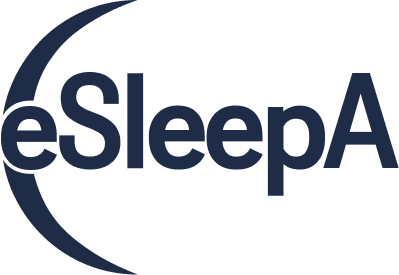
Keßler Solutions bearbeitet als Experte im Bereich der IoT-Sensoren und Backend-Systeme zur Datengewinnung und Verarbeitung das Teilvorhaben “IoT-Server und Anbindung”. Zentraler Bestandteil ist die Einrichtung des IoT-Schlafkoffers, dessen Verbringung vor Ort bei den Probanden sowie technischer Support. Der Schlafkoffer dient der nutzerorientierte Erhebung messbarer Einflussfaktoren aus der persönlichen Umgebung einer Person auf die Schlafqualität (z. B. Luftqualität, Temperatur, Lichtverhältnisse, Bewegung, Lärm). Über die im Schlafkoffer verbauten Sensoren werden bspw. Luftfeuchtigkeit, CO2- und Feinstaubanteil einmal pro Minute gemessen.
Der zugehörige Withings Sleep Analyzer ist eine Matte, die unter die Matratze gelegt wird, und ermittelt weitere Werte wie Atemfrequenz, Puls, Geräusche (z.B. Schnarchen), Bewegungen. Mit ihm kann Schlafapnoe festgestellt werden. Zu dem Projekt gehört auch die Smartwatch FitBit Charge 6 mit der App Google Fit, die ebenfalls viele schlafbezogene Faktoren, aber auch Bewegung und Stress erkennen kann. Ein Fragebogen für jeden Tag dient dazu, Gewohnheiten wie Mediennutzung und Essverhalten zu erheben, die nicht duch die smart devices erfasst werden können. In der Testphase wird eSleepA 9 Monate bei den Probanden untergebracht.
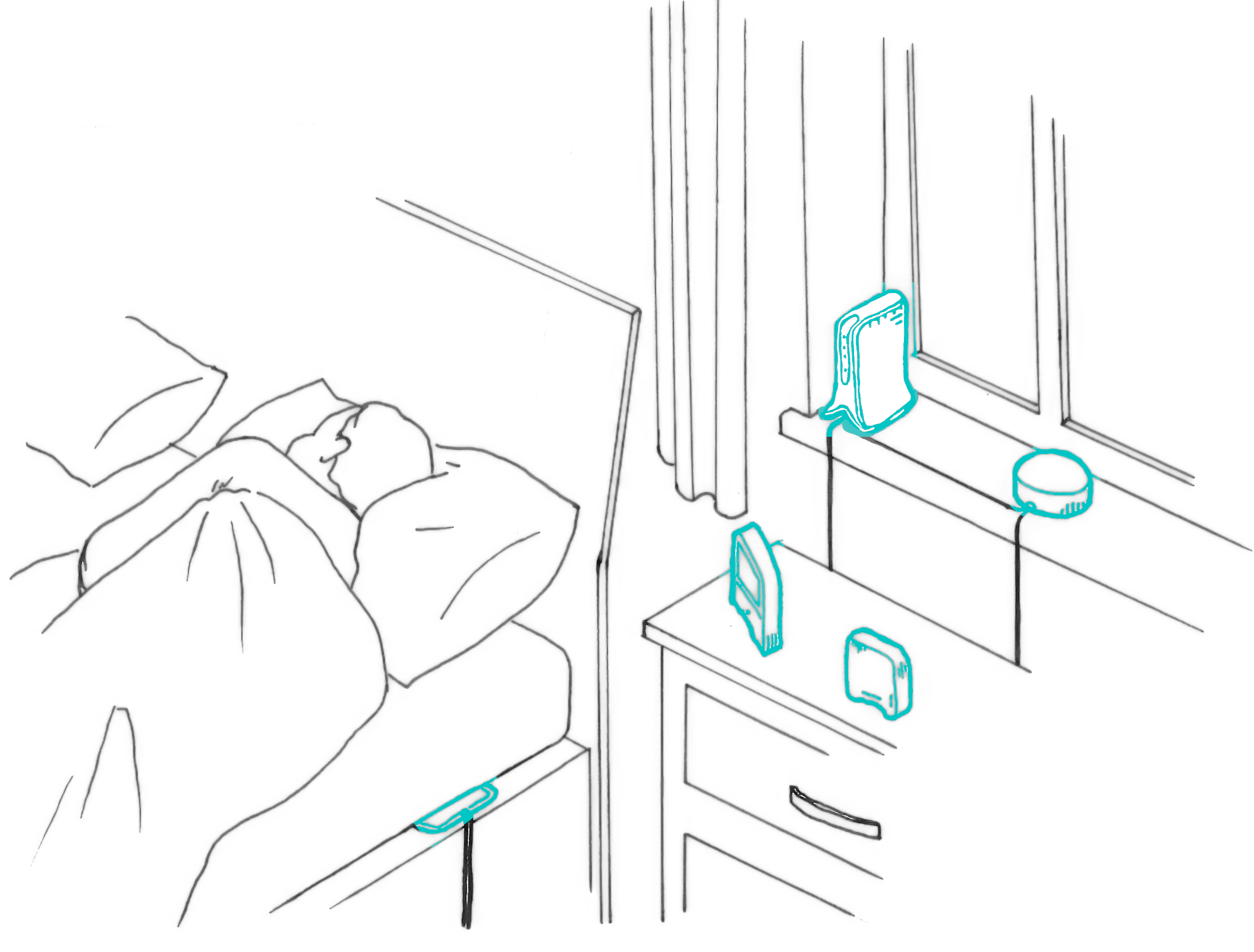
Sie möchten sich als Proband für das eSleepA-Forschungsprojekt bewerben?
Dann füllen Sie einfach das Kontaktformular mit Fragebogen aus:
Im Rahmen der Konsortialführung obliegt Keßler Solutions neben dem Teilvorhaben “IoT-Server und Anbindung” die Organisation und Umsetzung der Projektplanung (Arbeitspakete, Personalaufwand und Termine) des Förderantrages. Das Unternehmen konnte folgende starke Partner für das Projekt gewinnen:
Projektwebsite: coming soon! Ab März 2024 auf https://esleepA.science
Laufzeit: 1. Februar 2023 bis 31. Januar 2025
Förderung: ZIM-KF des Bundesministerium für Wirtschaft und Klimaschutz (BMWK)
Projektträger: AiF GmbH
Ansprechpartner Datenschutz: Datenschutzbeauftragter der Medizinische Fakultät Universität Leipzig, dsbmf [at] medizin [punkt] uni-leipzig [punkt] de oder 0341 97 161 05
Ansprechpartner bei Keßler Solutions: Marcus Mühlberg und Rabii Darbi
In order to integrate the BIM method as intelligent building data modelling into building operations in a practical way, it is essential to network the 3D building model with existing information, a CAFM system such as FAMOS, sensor technology and IoT. This is the only way to create a digital twin, which creates a direct, virtual image and can fulfil many of the promises made by BIM. In existing buildings, the digital twin enables sustainable, process-optimised facility management through, for example, preventive maintenance planning and control or optimised space utilisation.
MODELLING BIM IN EXISTING BUILDINGS
Creating a virtual building data model during the operating phase or during renovation or modernisation is a particular challenge. In contrast to a new building, a lot of current data is not available, e.g. exactly which materials were used where and how, etc.
EXPERTISE THROUGH PRACTICE
In recent years, the Keßler Group has gained extensive expertise in the development and application of the digital twin in existing buildings through concrete practical experience (more below).
USEFUL PLANNING
Before creating a BIM model in the existing building, it is essential to seek advice in order to agree on a standardised measurement concept, an appropriate procedure and an appropriate scope of data collection and georeferencing. Established BIM as-built models should also be checked for up-to-dateness once a year by means of an inspection.
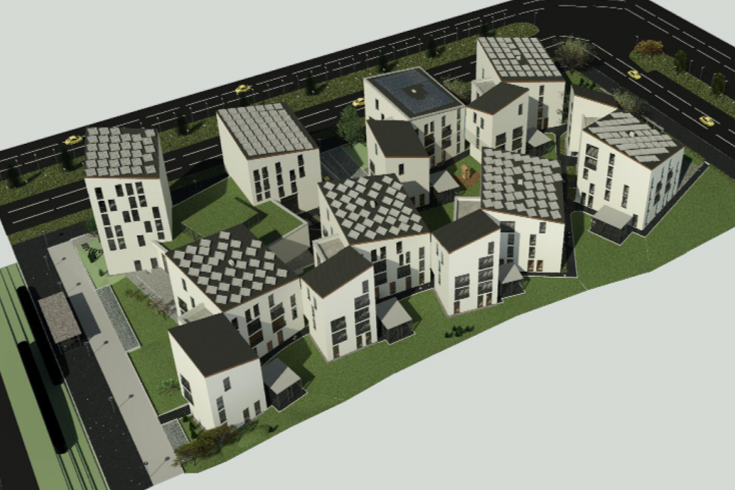
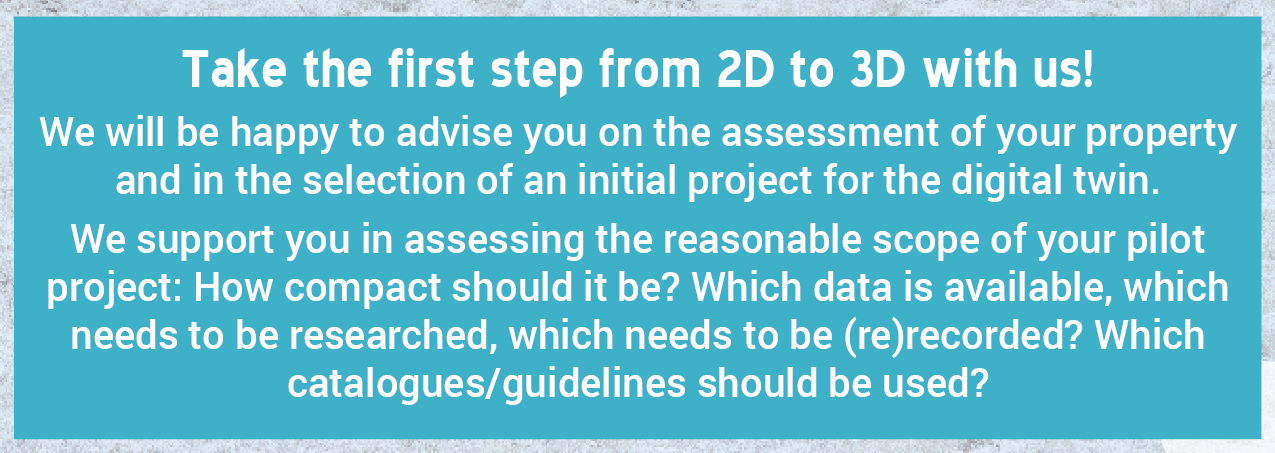
INTERFACE BETWEEN BIM AND CAFM
Autodesk® Revit® supports BIM and object-orientated work. The programme enables digital 2D and 3D models of properties that depict all the information of the originals. Via the bidirectional BIMflow interface for Revit, the FAMOS CAFM system offers you the option of integrating the models for a multidimensional, process-orientated view into the effective management of your buildings and facilities.
Keßler Ingenieur Consult specialises in surveying and digitisation projects in all service phases (design, planning and construction) as well as in existing buildings. The BIM portfolio for surveying land, buildings or industrial plants includes measurement concepts according to AIA, data collection (own collection as well as integration of third-party data), digital terrain models (2D/3D), georeferencing, geodetic measurement methods with 3D laser scanning, terrestrial photogrammetry, optimisation for FM software and as-built documentation (e.g. determination of rental space, room books).
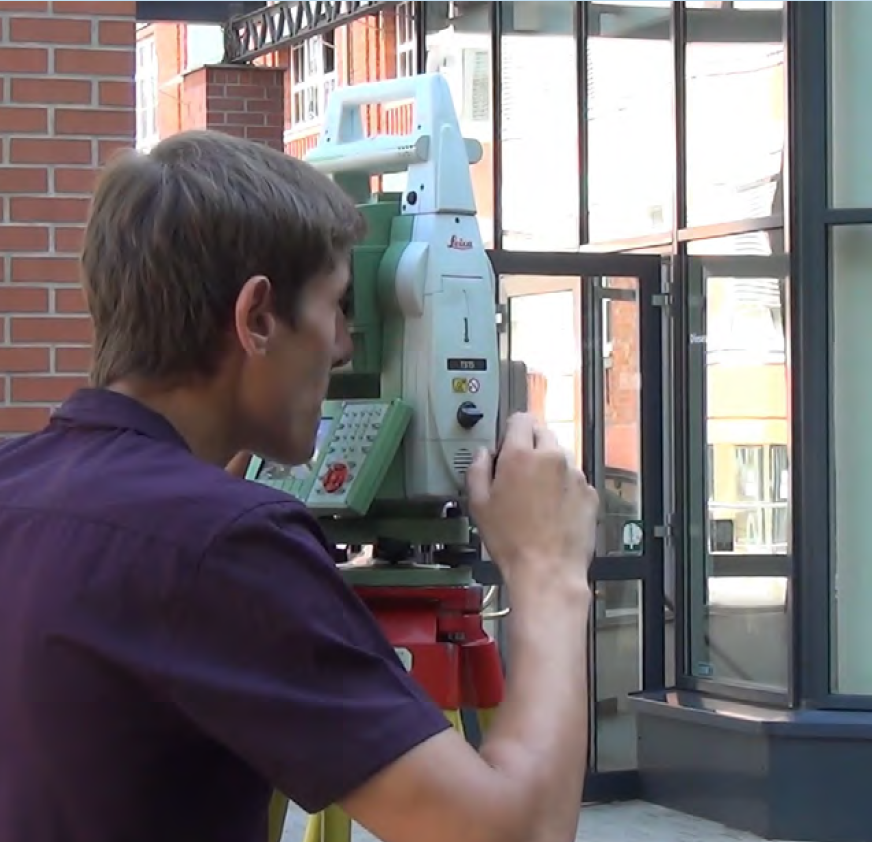
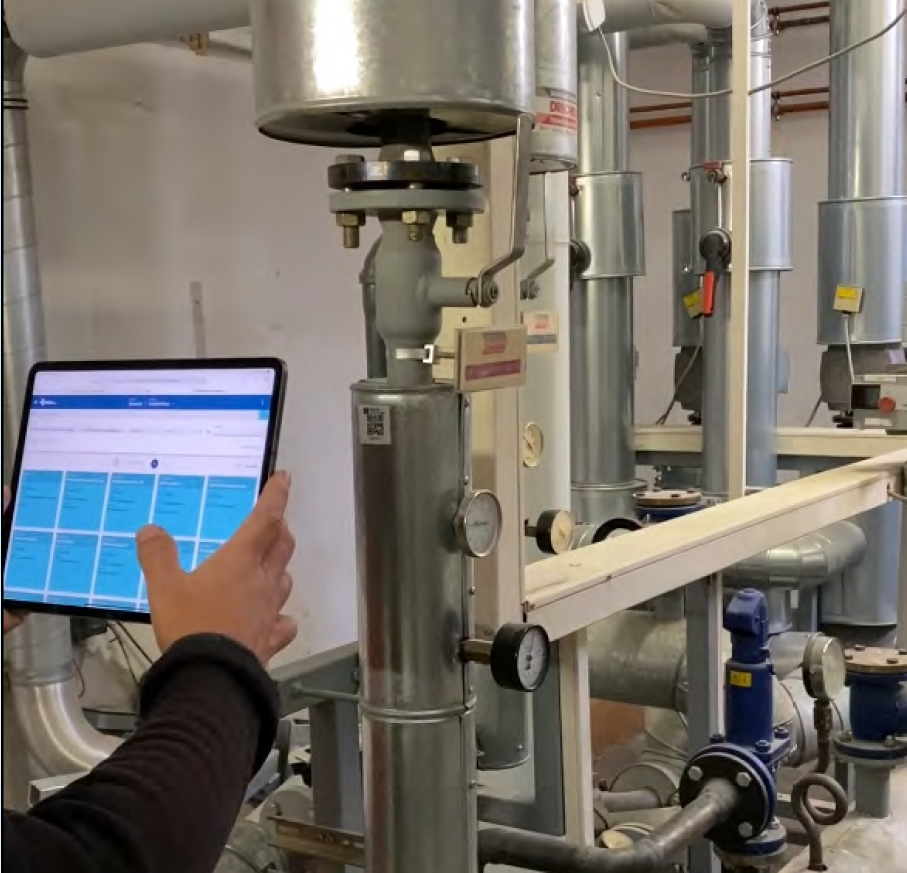
The company sister BCS GmbH offers further data acquisition services. Here too, a structured consultation and selection of the data to be digitised or checked for the first time takes place at the beginning: Recording of entire properties, individual properties, structural and technical installations, condition assessments and recording of installed IoT sensors or inventories. All required object types can be database-specific (Access, SQL, CAFM system), based on current guidelines (e.g. DIN 277, MFG, WoFIF), provided with QR codes and prepared in a CAD and BIM-compliant manner. The recorded data can then be used as the basis for an energy audit or a fire protection concept, for tenders or emergency property manuals, for example.
In recent years, the team at Keßler Solutions has gained practical experience in recreating a digital twin during the operational phase of a property. By consolidating external data (e.g. construction plans, order documents), self-collected as-built data and the correction or reconstruction of missing information, such as the addition of heights or sections to 2D plans for the 3rd dimension, simple to very compact models are possible, as the examples of Future Living® Berlin and the Keßler Solutions office show.
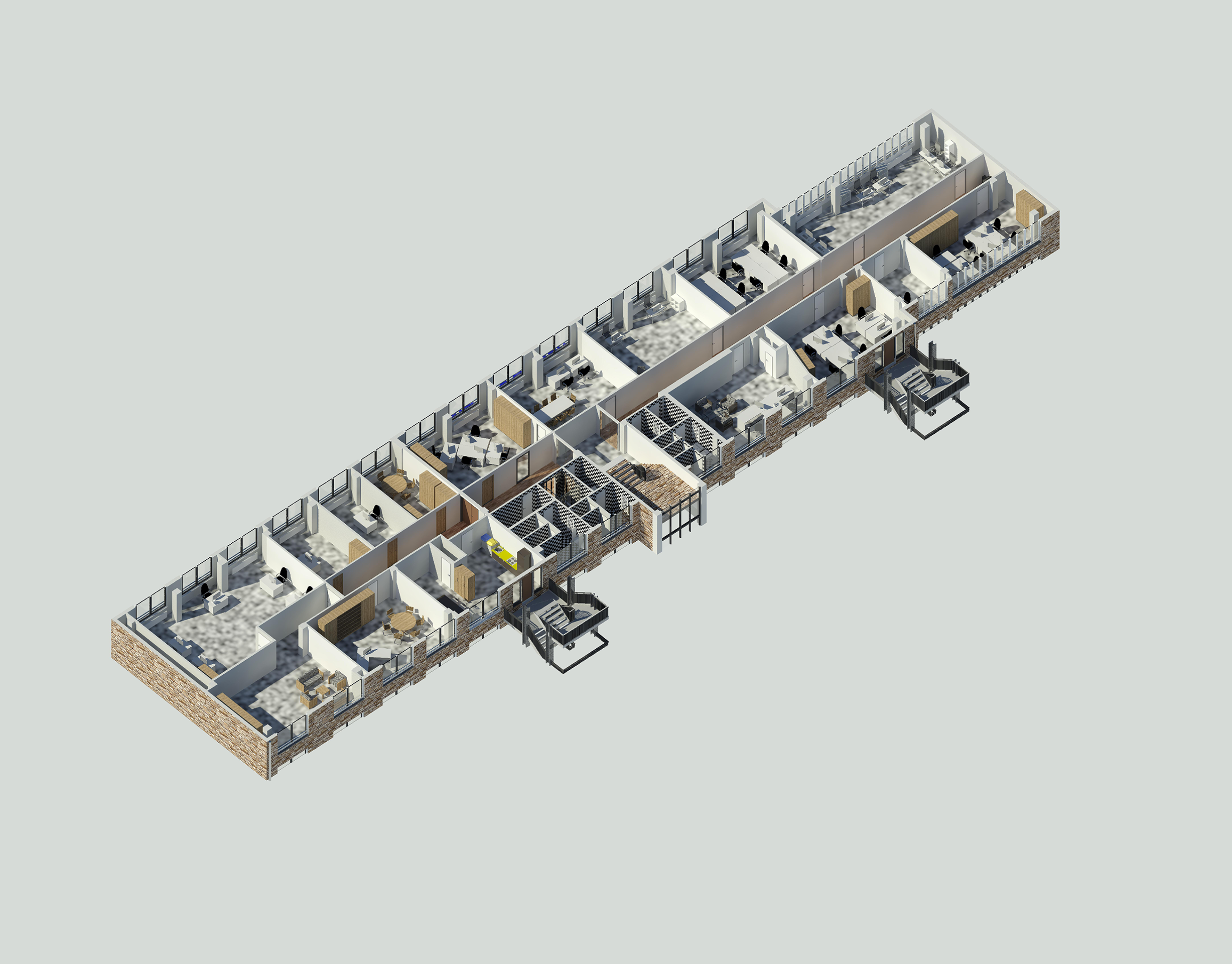
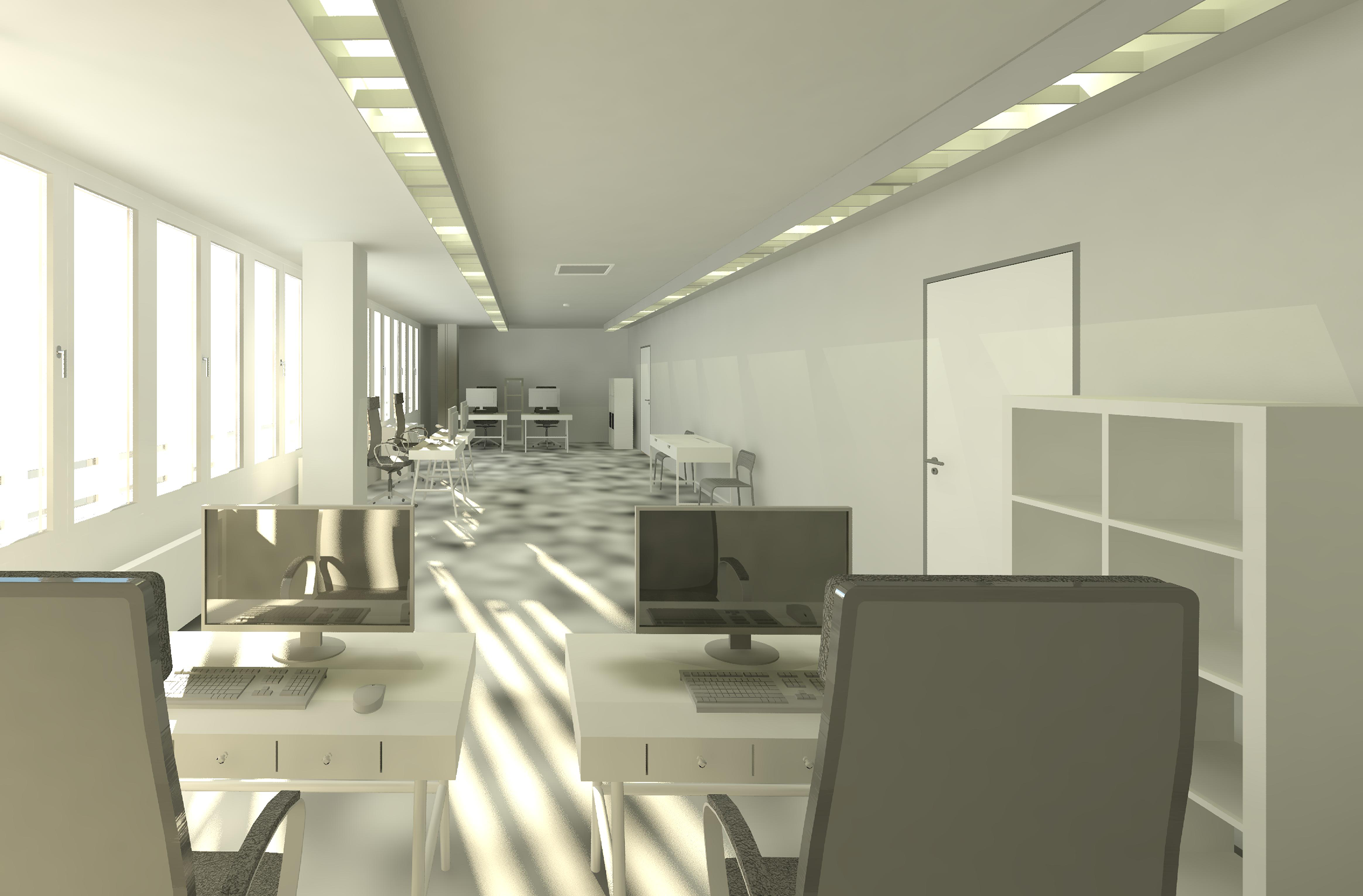
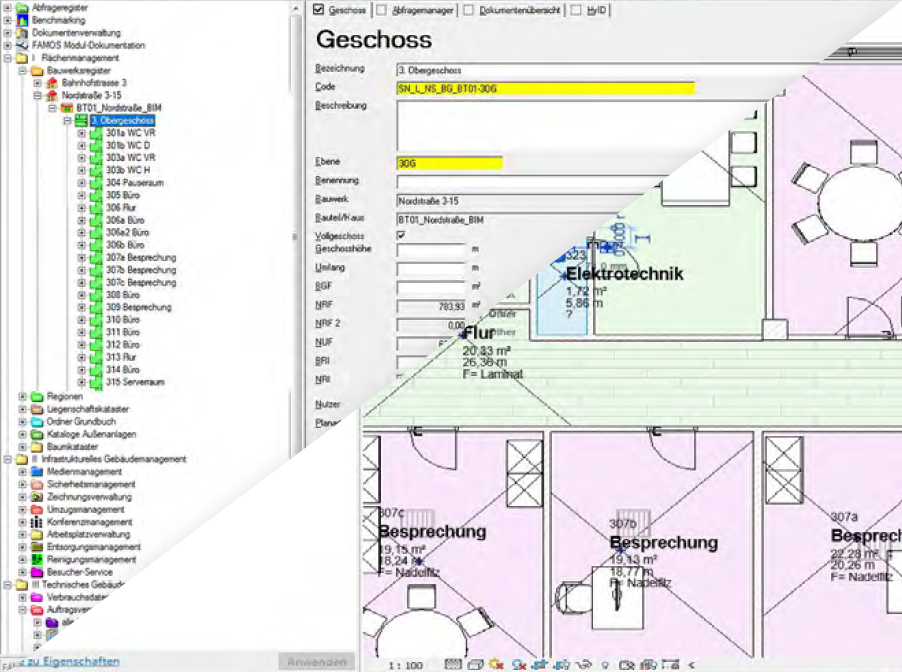
All data provides the basis for the various dimensions of the digital twin and thus for modern, sustainable and optimised management. The digitisation of building information not only supports current operations but can also be used for modernisation projects and conversions, regardless of whether it is used in a CAFM system.
Market research conducted by the Federal Institute for Occupational Safety and Health (BAuA) in 2020 on the mobile management of occupational health and safety (“e-health and safety”) in Germany shows that digitalisation in the field of occupational health and safety has strong growth potential. For example, the research shows that not even 2% of the (202) ICT solutions analysed used qualification and training management, and even fewer used digital operating instructions*. These proportions have certainly changed since 2020 – simply due to the increased requirements with and since the pandemic. However, many companies and institutions have still not tapped into this potential.
In recent years, there have been numerous optimisations of the occupational health and safety product package from Keßler Solutions, e.g. for instructions, the implementation of risk assessments and the creation of print-ready operating instructions via FAMOSweb including new manuals and workbooks, the management of hazardous substances and integration into the sustainability department with a view to the EU’s CSRD Directive. The team is now working on a powerful tool for qualification management with the following focal points:
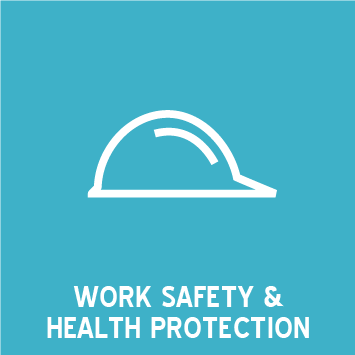
Companies and institutions are being sought as practice partners for the conceptualisation of the complex technical requirements for qualification management and for the test phase of the new functions. If you have experience in the field of qualification management and would like to manage the qualifications in your company using CAFM, we cordially invite you to expand our expertise with your specific practical experience.

The CAFM software FAMOS from Keßler Solutions manages a wide range of important information that is essential in the event of an emergency. This includes, for example, locations of fire extinguishers or first aid kits, responsible persons such as first aiders or radiation protection officers, internal or external service providers such as cleaning, property protection, lift technology or insurance as well as CAD plans such as evacuation plans or routing systems.
In the event of an emergency, it is essential that all relevant data is made available at a glance. Ideally, directly with specific instructions for action, for example:
We are looking for practice partners with experience in operational emergency management to support the conceptual design and practical testing of our emergency management tool. Help shape the future general average dashboard – as a central overview for all relevant information in the event of an accident!
Would you like to find out more about a practice partnership? Are you interested in optimising occupational health and safety processes based on your experience? Are you new to the topic of digital management of AuG? Then contact our Innovation and Product Manager Mr Marcus Mühlberg or your responsible project manager informally by 31.12.2023.
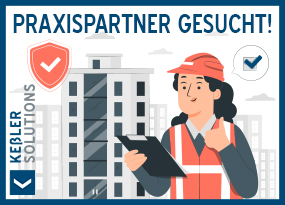
What do we expect from you?
We work in small project teams with various specialists from the fields of IT, project management, systems analysis and occupational, organisational and health psychology and pursue agile approaches in the software development process. Become part of the respective project team by supporting us online or on site with your expertise. We hold short project meetings at regular intervals (4 weeks) and as required to define the individual development steps (sprints) and evaluate prototypes and developed functionalities, to which you are cordially invited. You will have the opportunity to try out the new functionalities in a specially set up test environment and optimise them together with us. A prerequisite is the use of the CAFM software FAMOS for the project period, if you are not already using it.
This is what we offer you:
You receive a powerful tool for your qualification management and can actively help shape its functionality at the same time. If you are not yet working with FAMOS, we also offer a wide range of other facility, property and asset management solutions. As part of the project realisation and strategic cooperation, we offer reduced product prices as an incentive and provide you with the damage management module free of charge for 3 years.

*Source of the “Market research on German-language internet-based applications for the implementation of organisational regulations of occupational health and safety (“E-Arbeitsschutz”)”: To the website with download link
The climate crisis is one of the biggest challenges of our time. In Germany, the operation of buildings accounts for around 35% of energy consumption and around 30% of CO₂ emissions. In order to achieve the climate targets, it is therefore essential to make building management more sustainable. With the Corporate Sustainability Reporting Directive (CSRD), the European Union has adopted a new directive on sustainability reporting. The directive is intended to increase the transparency and comparability of sustainability reports and facilitate compliance with ESG reporting obligations.
The ESG scoring tool from Keßler Solutions is an innovative solution that helps companies and institutions to fulfil their ESG reporting obligations in an efficient and process-oriented manner and to make their building management more sustainable. The tool combines a variety of functions in a single platform, including
The ESG scoring tool collects data from various sources, such as CAFM, IoT platforms, maintenance systems, ERP/HR solutions and BIM. This data is processed automatically and in a structured manner to provide a comprehensive and transparent view of the property portfolio.
The condition of the property portfolio can be queried with regard to ESG criteria and presented using a scoring value. The individual holdings within a portfolio can thus be compared and priorities, e.g. for modernisation, can be set strategically. The ESG scoring tool supports the creation of standardised ESG reports in various formats that meet the requirements of different stakeholders. In future, reports in accordance with ESRS, the Global Reporting Initiative (GRI) or the German Sustainability Code (DNK) will be integrated.
Reduction targets and measures to adapt business models in line with climate protection: the ESG scoring tool helps companies to assess their buildings and recognise how well they meet their climate targets and ESG criteria. Thanks to an informative data basis, optimisation potential can be quickly identified and measures to increase the sustainability of your building management can be developed and implemented. The digital twin can be used to simulate the implementation of measures.

With regard to all five environmental objectives of the Taxonomy Regulation, the ESG tool provides references and opportunities, e.g. strategies for climate protection measures (e.g. integration of renewable energies), comparison of adaptation strategies to climate change through simulations in the BIM model, recording of water usage patterns through data analysis with subsequent consumption optimisation, BIM-supported material monitoring for a sustainable circular economy and recognisability and thus avoidability of environmental pollution.
The tool is scalable and can be customised to the individual requirements of companies of any size. The quality and reliability of the data are guaranteed by the tool.
Currently only available in German
Your contacts from the sustainability team:

On 28nd 29 November 2023, Keßler Solutions will be exhibiting at BIM world MUNICH for the fifth time. This year we have the IoT practice partner akenza as our guest! At stand 33 in the foyer, IoT sensor technology and augmented reality can be tried out live in the digital twin. You will also receive information about BIM & CAFM in property management, 3D and 2D models and their benefits in CAFM, products and services for data and process digitalisation as well as sustainable energy and environmental management with the help of BIM and IoT.
For congress visitors, we recommend the presentation by Managing Directors André Keßler and Jens Schmolik on the second day of the fair, 29 November at 11:05 a.m. on Congress Stage 4 – BIM4FM on The forward-looking role of augmented virtual reality for sustainable real estate management. The lecture will be held in German, the presentation slides are in English. The IoT-use case of damage management will serve as an application example – find out more below!
Would you like to visit BIM world MUNICH? Then secure your free ticket for the exhibition, breakout sessions and BIM Town!
Visit Keßler Solutions and akenza at stand 33 in the foyer! Arrange your on-site appointment with our trade fair team at the same time!
The next evolutionary stage of digitalisation will go hand in hand with the integration of modern technologies in everyday life. IoT and AR/VR enable the creation of and virtual participation in digital worlds. Speaker André Keßler and Jens Schmolik from IoT partner akenza will present suitable use cases with IoT, digital models and their networking in the CAFM system. Such a system is indispensable as a platform, as it provides fundamental (live) data in the context of modern, holistic management. This allows processes in CAFM to be initialised/managed directly from the management system.
The integration of modern technologies and BIM dimensions into management creates efficiency and innovation, especially for investors and service providers. The potential for the structured, sustainable management of construction and building operations is enormous. Damage management serves as an IoT use case. In property management, this is crucial in order to effectively prevent and manage unexpected events and damage to properties. Keßler Solutions and akenza have combined damage management with IoT and digital models. Intelligent Agents and mechanisms identify potential weak points, warn in the event of acute damage or detect anomalies (e.g. illegal unauthorised removal). With the help of an AR image of the digital twin, technical staff can be directed to the scene of the incident* in the event of such or other alerts. Similar to a remote service, the technicians receive specific work orders and/or assistance instructions directly from the system while on the move on site –the virtual world supports reality. Such end-to-end processes, which display inconsistent resource consumption and thus avoid waste, which effectively design maintenance processes and thus relieve employees, which integrate sensors to immediately display hazards and thus optimise user safety, and which can do much more, offer great potential for the management and modernisation of real estate portfolios according to ESG criteria. In the presentation, the partners Keßler Solutions and akenza will give you a comprehensive and practical insight and look forward to your questions and/or your visit to stand 33, foyer.
* Visiting the digital twin in an AR environment is useful for a wide range of other stakeholders: virtual viewings, e.g. for prospective tenants who cannot come on site, as well as indoor navigation for visitors with restrictions or relocation management are further use cases.
**Iot and AR promote the fulfilment of the requirements for more sustainability in the building sector, e.g. through constantly updated data for sustainability concepts and reports and their success monitoring, through virtual variant planning with various optimisation measures or second life concept comparisons.
Click here for the full congress programme.
The recording of the web event with akenza: “IoT in the interplay of management” (in German).
The recording of the web event “CAFM and BIM” from 7.2.23 on Youtube (in German).
Press release 7.12.22: Comprehensive expertise on the digital twin in existing buildings.
Review of BIM world MUNICH 2022 with “Sustainability through data in BIM”. (currently only in German).
Review BIMuc22.
In April of this year, Managing Director André Keßler presented the company’s own approach to sustainable business models at the Web Event “Sustainable management in FM through CAFM and services” (in German). The visualisation is based on various specialist sources, such as the 3-pillar model with economy – ecology – social aspects as the equal pillars of sustainability. The three strategies of sustainable development must be applied in a complementary manner: Work better with what is available (efficiency),Analysing and tackling what can be changed (consistency) and creating awareness that “less of” is also an optimisation (sufficiency). External and internal transparency is also of central importance to Keßler Solutions and a necessary component of integrated, holistic business models.
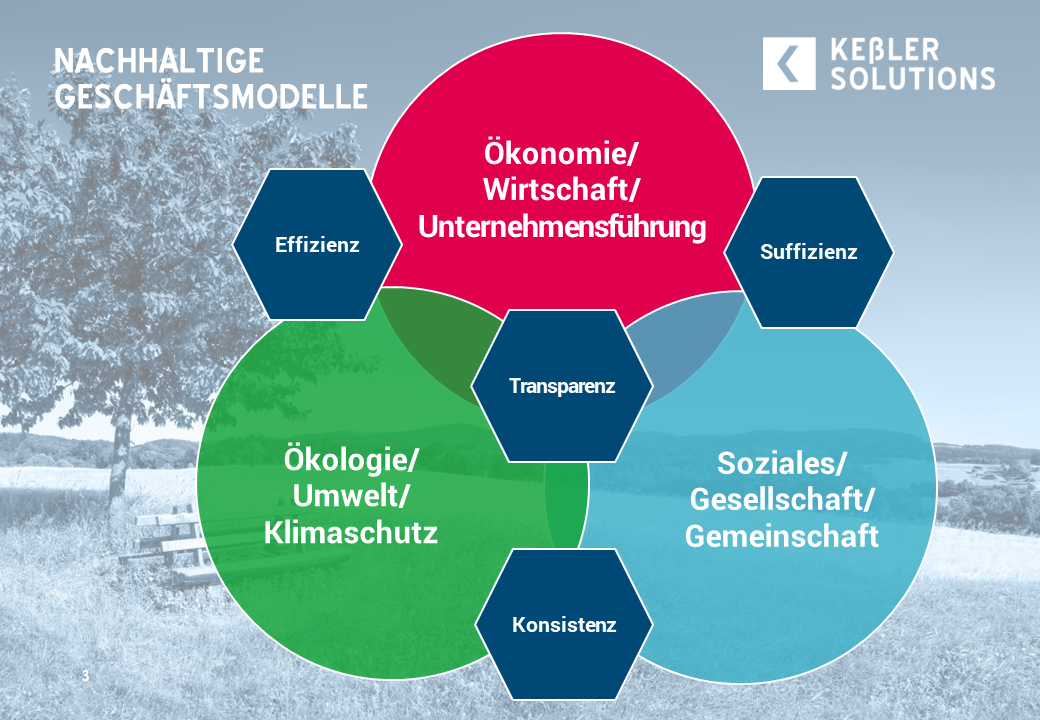
For the broad subject area of “occupational health and safety”, there is an equivalent for all elements, for example:
The scope and complexity of the tasks involved and the associated significance for the company as a whole make it clear that “occupational health and safety” is a central task of company management. All associated measures are important components of operator responsibility and therefore a management task: employers and property/plant operators are responsible for the safety and health of all user groups.
In the first half of the year, Keßler Solutions therefore decided to define the “Safety and occupational health” product portfolio as a central component of sustainable management and operation. Products and services are integrated into the “Sustainability” department. As part of the reorganisation, the overall package of modules, processes and services was given the new name “Occupational Health and Safety”.
Managers are responsible for the fulfilment of statutory minimum standards (e.g. Occupational Health and Safety Act (ArbSchg) or Ordinance on Industrial Safety and Health (BetrSichV)). If necessary, tasks from the respective area of responsibility are to be delegated to trained specialist personnel. The implementation of these tasks should be documented in a comprehensible and transparent manner in order to fulfil the legal requirements. The team at Keßler Solutions has created new work materials for users of “AuG” in order to provide the best possible support for those responsible.
Users of the FAMOS CAFM system can be provided with a detailed and constantly evolving workbook. This goes far beyond the standard manual: process-orientated, concrete questions and requirements from practical application are worked through using real-life data.
A fictitious company with its own employees and company processes forms the framework scenario. Practical situations are played out in dialogue form with the relevant persona, e.g. Technical Manager Manfred Stark and FAMOS Administrator Anna Lühse, e.g. How do I create a risk assessment for a new TGA? An audit is due – what do I need to prepare? How do I draw up operating instructions? What happens after an accident at work?
The highlight: the fictitious company with all the processes discussed is integrated into the presentation database of the FAMOS CAFM system, so that these scenarios can be tested during introductions or training courses in the product family. Process overviews, so-called FAMOSkompakt, summarise and visualise the best practice examples. After familiarisation/training, these form a short and clear reminder at a glance.
Both – workbook incl. FAMOSkompakt and demo database (still only in German) – are constantly being expanded, e.g. if further use cases become available or if there are legal changes to procedural requirements.
Details on the occupational healtyth and safety can be found on the website on the topic:
Efficient and sensible WORKPLACE MANAGEMENT is appreciated by many employers and is even necessary with a view to sustainable building management. The “New Work” has brought new challenges for employers. For example, mobile working is increasingly leading to fully or partially unused office space. One component that is directly affected by this is media consumption, with a particular focus on heating and air conditioning: whether these are switched on for one person or for a dozen – they are running.
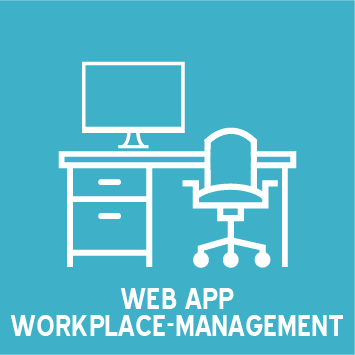

The social component of “dispersed employees” is a factor that can have a negative impact on internal communication: Employees sit isolated from others and it is sometimes not clear who is in the office and when. By consolidating work zones, consumption such as isolation can be specifically avoided or optimised. Systematic optimisation measures increase user satisfaction, simplify administration and save resources.
With the Workplace Management web app, you can coordinate workplaces and their capacities in a clear and mobile way. Modern functionality and a contemporary, intuitive design guarantee high usability.
If you use Workplace Management independently, the master data is created directly in the application. If you use the web app with FAMOS, the data is easily synchronised.
In the next step, work zones and workstations are defined or assigned with detailed information (e.g. location, equipment, directions or tags). Coordinates are also determined in order to localise workstations and zones on the map view. The administrators also define rules, such as opening hours. End users can only reserve workstations and zones that have been authorised by their specialists.
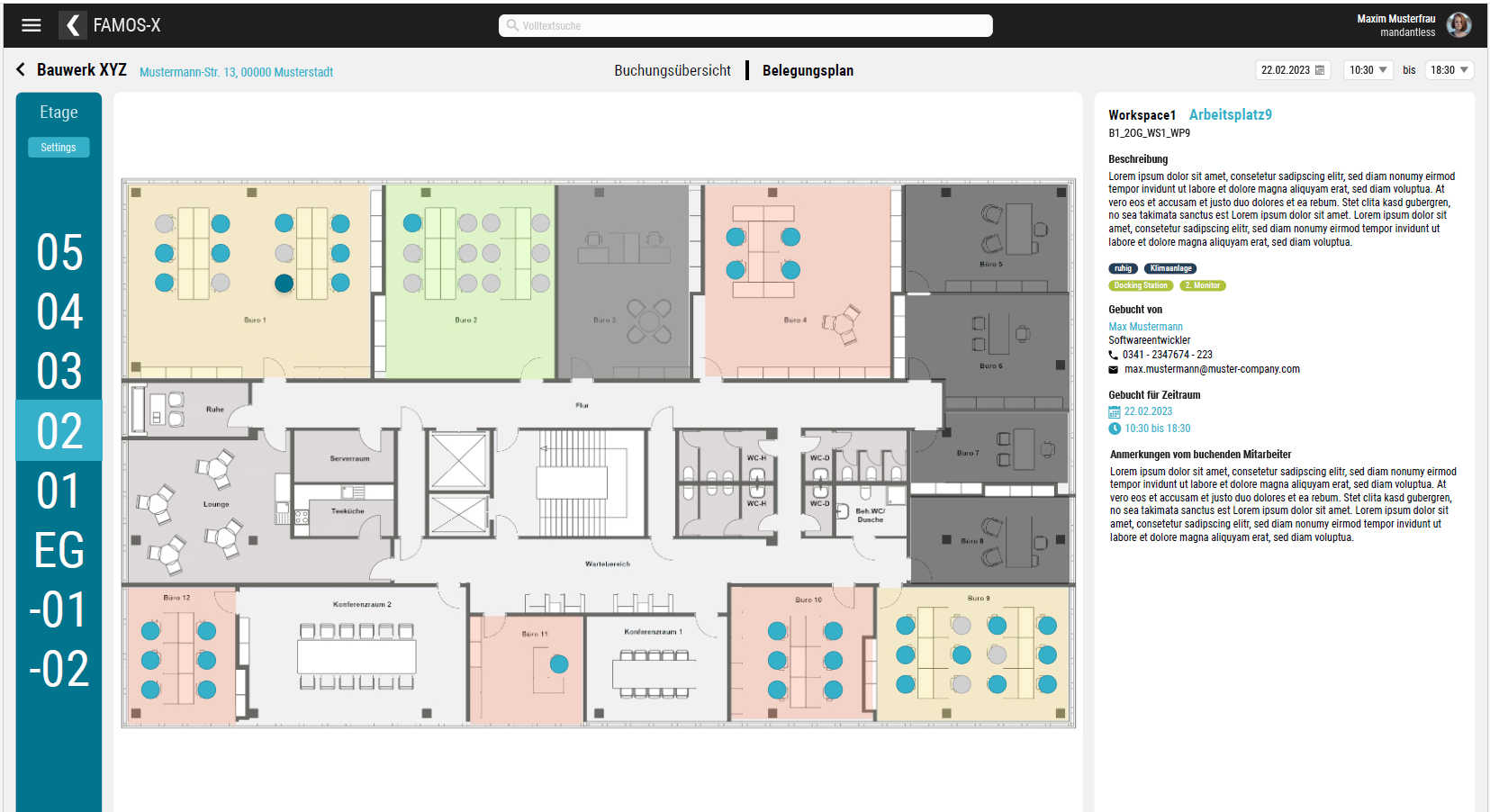
Managers can quickly identify optimisation potential thanks to the graphical visualisation of reservations and active bookings in the dashboard. The occupancy plans make it very easy to see how the occupancy rate is and whether optimisation measures should be implemented. To save energy resources, for example, the specialist changes the booking rules for work zones. Users are automatically and immediately informed of changes and can react quickly by making a new reservation.
The booking history in the web app and various (anonymised) reports in FAMOS make it possible to control the number of users and fluctuations over time. Systematic evaluations can be used, for example, to adapt rules in order to steer the reservation behaviour of users in a direction that consolidates the use of space and thus optimises the consumption of resources.
Users reserve/book required workstations or zones (e.g. areas) early or spontaneously as required. Depending on the desired location and/or date, free capacities can be quickly viewed using the booking overview. The map view provides directions. Thanks to the system’s constantly updated booking data, employees are informed about available workspace capacity even at short notice. The booking is activated via the “Check Inn button” in the app or manually on site by scanning a QR code at the workstation. This means that spontaneous bookings can also be made directly at the workplace if you are already on site.
Details in the descriptions, tags as well as search and filter functions help you find the optimal/ideal workspace (location, volume, equipment, etc.) for any period of time. Reservations can be easily created, changed and cancelled; if the desired workspace is free, it can be booked earlier and extended. Preview and booking history clearly show all your own reservations and bookings. Saving user preferences,e.g. location and equipment, as well as repeating bookings simplify handling for the user enormously, and after a booking it is possible to rate the workplace.
Flexible, independent and mobile – discover the Event Management and ServiceTicket apps.
Advantages of data and process digitisation: Make strategic decisions based on your data!
Interested in our topics? Then register for the FAMOS newsletter without obligation (only in German):
The interaction between the Internet of Things (IoT) and Computer Aided Facility Management (CAFM) has the potential to significantly improve the efficiency and effectiveness of facility management. The IoT enables the networking of physical devices and sensors, while CAFM offers software solutions for the management and optimisation of buildings and facilities as well as operations. The combination of both technologies creates a powerful synergy.
![]()
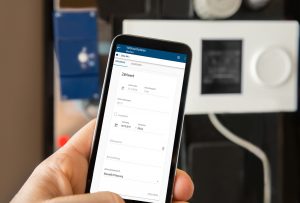
The IoT provides real-time data from various areas such as energy consumption (media consumption), room occupancy, security systems and maintenance requirements. This data is transferred to the CAFM system, which analyses it and converts it into relevant information for facility management. This enables facility managers to react proactively to problems, for example by planning maintenance work before a device breaks down or optimising resources to reduce energy consumption.
The integration of IoT and CAFM also enables the automation of processes. For example, the IoT network can detect sensors when a room is not in use and automatically switch off the lights or turn down the heating to save energy. CAFM systems can use this information to identify vacant spaces and optimise costs or service contracts and orders.
Overall, the interaction between IoT and CAFM opens up new opportunities for facility management. By networking devices, automating processes and utilising real-time data, facility managers can use their resources more efficiently, reduce costs and improve the performance of their buildings and facilities. From a sustainability perspective, IoT is therefore an important key technology in management that should not be underestimated.
On 20.06.23, the two partners Keßler Solutions and IoT partner akenza presented themselves together in a web event on the interaction of IoT and CAFM. They showed various solution approaches, e.g. for easy retrofitting of sensors in practice: akenza presented easy-to-integrate used cases of the path of sensor data into the platform in the live part. The Recording is published on Youtube (only in German).
A lot has happened in the interdisciplinary research project “ForeSight: Platform for context-sensitive, intelligent and predictive smart living services” in 2022. The BIM method plays a central role for the project team in the areas of sustainability, resilience and digitalisation. In 2022, the team from Keßler Solutions built the digital twin into the existing structure.
The ForeSight project was launched in spring 2020 as part of the innovation competition “Artificial intelligence as a driver for economically relevant ecosystems” organised by the Federal Ministry for Economic Affairs and Energy and grew out of the partner network around the smart city district Future Living® Berlin in 2019 [Find out more: News from 17.12.2019].
In order to be able to offer context-sensitive, intelligent and forward-looking smart living services in facility management, up-to-date and networked data and information systems are required. One such system is the CAFM solution FAMOS. As a control centre, FAMOS connects, for example, rental spaces with ERP software and thus enables numerous rental management processes. The integration of IoT and smart services into CAFM is one of the defining topics in modern building management.
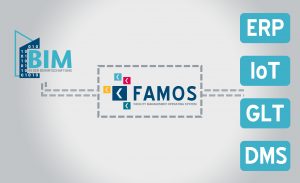
In order to integrate the BIM method into building operations in a practical way, it is essential to network the 3D model with existing information, a CAFM system, sensor technology and IoT. This is the only way to create the digital twin, which creates a direct, virtual image and can fulfil many of the promises made by BIM. In 2022, the corresponding product and service area of FAMOS and Keßler Solutions will be strengthened: with the help of BIM models, the Keßler Solutions team can create a digital twin and synchronise it bidirectionally with FAMOS.
BIM practice in a smart urban neighbourhood
The blueprint for the research and development approach was the newly created Future Living® Berlin neighbourhood of GSW (a housing association based in Baden-Württemberg) with its 90 residential units and 10 commercial units and a total area of approx. 7,600 m2. After the tenants moved in in January 2020, Keßler Solutions began digitising the structural and technical facilities and recording all the installed IoT sensors, furniture and outdoor facilities.
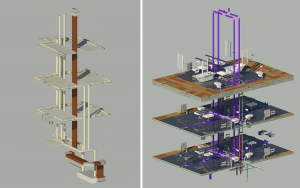
3D model of the existing building
After collecting the inventory data, a new 3D model of the neighbourhood was created in Revit® based on old CAD plans and orders and all trades (such as electricity, heating, air conditioning, plumbing, IoT) were integrated as an example for building 10. The model serves the research partners in the ForeSight project as a blueprint for a digital twin and also provides GSW with the basis for subsequent maintenance.
New expertise with the BIM model
What is exciting in this context is that the team at Keßler Solutions was able to recreate the digital twin on the basis of CAD plans, order documents and as-built data. Based on this expertise, customers can also have a BIM model created from their as-built data and thus be effectively supported in the digitalisation of building information. Together with the service areas of CAD processing and on-site surveying, modelling approaches or using laser scanning or other methods are also conceivable in order to enrich models with even more information. The new expertise can also be applied to modernisation projects and conversions.
Benefits of the BIM method in existing properties
Another advantage for operators and investors is that such models can be used as the basis for a virtual inspection before construction begins and/or digital exposés to initialise sales at an early stage. Simulations, for example of the path of the sun, help with the orientation of the flat. Material catalogues support the design of the flat furnishings and help future owners/tenants to get a better impression of their future flat.
The ForeSight research project will come to a successful end for all partners in March 2023. Keßler Solutions is looking forward to shaping the next ideas with GSW and the partners from Future Living® Berlin.
Smart and sustainable: The Future Living® Berlin neighbourhood from the ground-breaking ceremony to the present day:
The future of energy-efficient, safe and comfortable living: the ForeSight research project:
Role of the digital twin for sustainability, resilience and digitalisation (News from 31.05.22):
Sustainability through data in BIM – evaluation of the trade fair presence at BIM world MUNICH 2022.
Article BIM in operation with FAMOS in “Bauen Aktuell” (3/2021) as a free e-paper.
Specialist article on energy efficiency and smart management through BIM in “Computer Spezial” (2/2019).
The roots of Keßler Solutions go back to 1990 , when the surveying and engineering office Keßler (VIK)* was founded in Leipzig on the day of reunification. Five years later, in 1995 , an independent department was spun off with the task of driving forward the research and development of facility management software. This department also deals with new technologies for FM-compliant information and data acquisition.
In April 1997 , the final foundation stone was laid for the now 25-year success story of Keßler Solutions. The following year saw the market launch of the CAFM software FAMOS. FAMOS stands for Facility Management Operating System and is today one of the most established CAFM systems for commercial, technical and infrastructural management processes of all kinds in German-speaking countries. In July 1999, Gebmess®-Data GmbH was founded as a further part of the Keßler Group. This merged with Keßler Solutions in the summer of 2001 .
The company is a committed member of GEFMA (German Association for Facility Management) – FAMOS was one of the very first CAFM systems to be certified in accordance with GEFMA Guideline 444 in 2010. Managing Director André Keßler is the contact person for the Central Germany regional group of the professional association for facility and real estate managers RealFM eV Together with Matthias Thieme, he founded BCS GmbH in 2015, whose services further expanded the portfolio of the Keßler Group. In 2018, the company initiated the BIM Competence and Technology Center with partners. Since 2021, Keßler Solutions has also been active in the German PropTech Initiative (GPTI).
Over the years, Keßler Solutions has established itself from a 90s start-up to a full-service partner for holistic solutions in data and process digitization . Key topics include automation and optimization in maintenance management, sustainable management throughout the entire building life cycle and the efficient exercise of operator responsibility. The integration of digital technologies plays a key role here. The portfolio includes numerous consulting and other services for the holistic handling of projects.
The many years of experience of the employees, from customer-specific FM processes to comprehensive large-scale projects, have convinced over 100 customers from industry, the service sector and trade, the public sector, technology and development. Numerous practical and research partnerships with universities and industry are an important building block for Keßler Solutions to offer modern, future-proof and innovative solutions on the market and to develop new ones.
In view of the path it has taken so far and against the backdrop of ever-increasing demands for ecological, economic and social sustainability, Keßler Solutions is positioning itself as a reliable partner in facility and corporate real estate management.
The team, including family members, celebrates the company’s milestone birthday in mid-October. This was already celebrated with customers and partners at the user meeting in spring. The 25th anniversary of the FAMOS CAFM software will then be celebrated together at the FAMOS User Forum in May 2023.
* In 2018, the VIK reorganized itself as Keßler Ingenieur-Consult Vermessungs- und Ingenieurgesellschaft mbH. (more…)
Easily overcome the challenges of initial digital recording of building data in existing buildings with WA-T-01 Asset Recording. Initial recording is often very time-consuming if no data is available or can be supplied. With the app, you can efficiently collect and systematise object structures of all types, of assets e.g. plant, machinery, works of art, equipment, vehicle fleet, etc., saving time and money. You can also use mobile data recording to update existing, possibly outdated, inventory data.
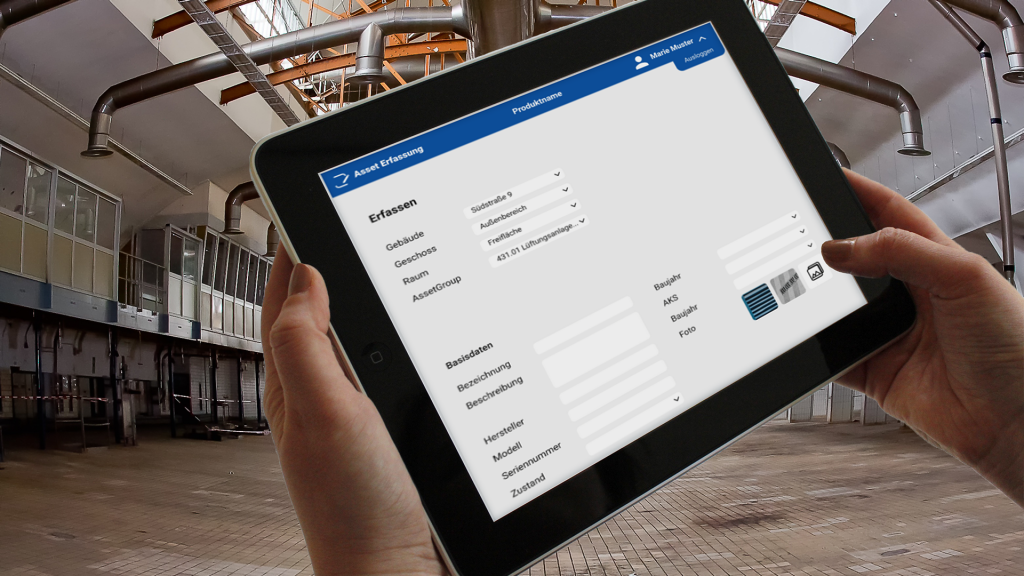
Building and property data contain numerous optimisation potentials for various management processes. Use the application to effectively utilise your building data, e.g. for CAFM systems or corresponding applications. Create the basis for sustainable energy and environmental management, safe maintenance management or modern workplace management. Form the basis for optimised and transparent planning of construction processes and budgets for structured modernisation/renovation projects. Obtain data for the valuation of your property for new lettings and sales. Easily fulfil your verification and documentation obligations.
Arbitrary data structures, the multitude of asset types in catalogs, inconsistent structuring of extensive forms, lack of support for mass data capture or different target systems are just some of the challenges that increase the effort and costs of data capture projects. With the new Assettool, Keßler Solutions makes it possible to define a systematic schema for describing your data structures. Flexible, efficient and user-friendly, mobile data capture simplifies the work of your team.
No capacity? Lack of experience? Why not outsource the collection/maintenance of your data to BCS?
In KW 37 wird die FAMOSweb-Version 2.8 freigegeben. In dieser ist bspw. das Scannen von Bar- und QR-Codes so angepasst, dass es unabhängig von einer app auch über den Browser mobil funktioniert. Dies ermöglicht u.a., dass eine Begehung oder Mangelerfassung direkt nach dem Scan des QR-Codes an einer Anlage oder einem Inventar begonnen werden kann. Weitere Ergänzungen in der Web-Begehung sind die Implementierung von Checklisten zur Erfassung von Mängeln sowie neue Filter und Suchfunktionen.

Kleinere Optimierungen gab es in der usability, z.B. bei den Favoriten-Einstellungen im Web-Auftragsmanagement oder beim Handling der Formulare. Mit der Freigabe von FAMOSweb 2.8 Version sind auch die in der Version 2.7.3 enthaltenen Änderungen final freigegeben. Basis für die Webversion 2.8 sind die FAMOS 4.4 SP6 oder FAMOS 4.5.1 SP2.
Erfahren Sie im kostenfreien Webinar, wie Sie mit FAMOSweb Ihre Bewirtschaftungs-Prozesse rund um die Uhr mobil gestalten.
Was FAMOSweb alles kann, erfahren Sie übersichtlich in unserem Vierseiter zu den Webmodulen und FAMOSapps (pdf).
Lesen Sie hier, wie sie mit Hilfe der Digitalisierung zukunftsfähig werden – mit Praxisbezug zu Bau und Betrieb.
Am 29. August begrüßte das Team von Keßler Solutions die neuen Azubis für die Bereiche Entwicklung und Projektbearbeitung. Drei frische Köpfe fingen direkt im Betrieb an, ein vierter begann in der Schule die Ausbildung zum Fachinformatiker. Um allen einen angenehmen Start zu bereiten, wurde in gemeinschaftlicher Teamarbeit – von Sperrmüll bis Deko – ein komplettes Büro neu hergerichtet.
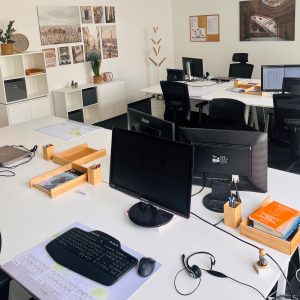
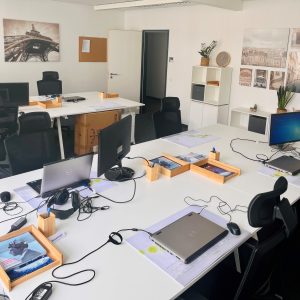

Seit Frühjahr wächst das Unternehmen sukzessive: Support, Projektleitung und Datendigitalisierung/ BIM freuten sich über neue Kollegen. Das Produktmanagement und die Entwicklungsabteilung haben zudem zwei ausgelernte Mitarbeiter fest angestellt. Auch deshalb blieb es nicht nur bei dem Raum für die Azubis: Wegen des vornehmlich mobilen Arbeitens wurde ein kaum genutztes Zimmer in eine moderne, helle Büroflächen für flexibles Arbeiten ungestaltet.
Wir freuen uns stets über Teamzuwachs! Schreiben Sie gern eine Initiativbewerbung, falls es keine passende Stelle gibt!
Entdecken Sie weitere Chancen zu weiteren Job-Profilen bei unseren Partnern in der Keßler Group.
Vernetzen Sie sich mit Keßler Solutions auf LinkedIn!
Seit 25 Jahren hat sich Keßler Solutions die nachhaltige Digitalisierung und Automatisierung von Daten und Prozessen auf die Fahnen geschrieben. Dafür stellt der CAFM-Anbieter praxiserprobte, innovative und nutzerfreundliche Lösungen zur Verfügung. Als Full-Service-Partner wird das umfassende Produktportfolio um verschiedene Services ergänzt, um eine ganzheitliche Prozessoptimierung zu erreichen.
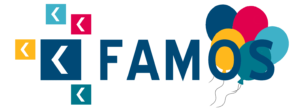
Sie bleiben flexibel.
Dank des modularen Aufbaus der Produkte, Prozesse und Services können Sie sich genau die Lösung maßschneidern, die Ihr Unternehmen benötigt.
Sie vereinfachen Ihre Prozesse.
Ihre Datenbank ermöglicht Ihnen stets den Zugriff auf aktuelle Informationen: eindeutige Daten, transparente Prozesse, konkrete Ergebnisse.
Sie bleiben Sie selbst.
Durch den flexiblen Aufbau und Zugriff auf bewährte Schnittstellen lässt sich FAMOS problemlos in Ihre gewohnten Abläufe integrieren.
Sie bleiben unabhängig.
Über die Web-Oberfläche ist FAMOS von allen Endgeräten aus mobil nutzbar. So behalten Sie an jedem Ort und rund um die Uhr die Kontrolle.
Sie entwickeln sich weiter.
Mit den für Sie passenden Produkten und Services optimieren Sie Ihre Arbeitsprozesse nachhaltig und werden fit für die digitale Zukunft.
Sie gehen auf Nummer sicher.
Keßler Solutions ist nach dem gefma-Qualitätslabel in 16 Kriterienkatalogen der Richtlinie 444 zertifiziert (2020 bis 2022, Katalog 17 geplant).
Sie optimieren ganzheitlich.
Eine nachhaltige Gesamtlösung, für Sie kombiniert aus einzelnen Modulen, ganzen Prozessketten und Consulting, ist maßgebend.
Sie investieren in Ihre Zukunft.
Profitieren Sie von 25 Jahren Erfahrung, einem starken Partnernetzwerk und der steten Weiterentwicklung von Produkten und Services.
Sie gewinnen weitere starke Partner.
Mit der Keßler Group steht Ihnen die geballte Kompetenz für alle Gebäudelebensphasen versierter Partner zur Verfügung .
Lesen Sie hier, wie sie mit Hilfe der Digitalisierung zukunftsfähig werden – mit Praxisbezug zu Bau und Betrieb.
Erfahren Sie im kostenfreien Webinar, welche Potentiale zur Daten- und Prozessoptimierung in einem CAFM-System stecken.
Optimierte Datendigitalisierung: Mehr zum Dienstleistungsportfolio der Keßler Group erfahren Sie übersichtlich im pdf-Infoflyer.
Pressemitteilung vom 03.02.2021 (PM als pdf)
Wie bei so vielen Projekten waren Präsenzveranstaltungen auch für das BIM Kompetenz- und Technologiezentrum 2020 nicht möglich. Aufgrund der Vielzahl der Partner des von der evermind GmbH koordinierten BIM-Netzwerks fand allerdings bereits schon seit der Initiierung 2018 ein Großteil der Kommunikation digital statt. So konnten auch in der 2. Phase des BIM Kompetenz- und Technologiezentrums die bestehenden Themen und neue Projekte kontinuierlich fortgeführt werden. Im Ergebnis befinden sich drei weitere Forschungs- und Entwicklungsprojekte in der Antragsphase und zehn neue Partner sind aufgenommen, womit das Netzwerk nun bereits sechs Praxisprojekte und 19 Partner vorweisen kann.
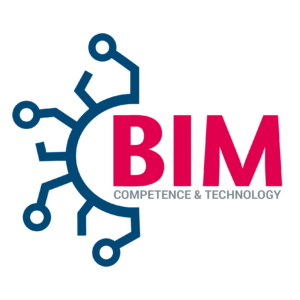
Bereits gestartet ist das Projekt Indoor Blinden Navigation, in welchem auf Basis von BIM-Modellen und semantischen Informationen ein alltagstaugliches Navigationssystem für sehbehinderte Menschen aufgebaut werden soll. Beim Projektträger ZIM (Zentrales Innovationsprogramm Mittelstand) sind die Anträge für die Projekte IoT Sensor-Gateway und BIM2Fabrik in der Prüfung. Bei beiden geht es um die Digitalisierung und Optimierung von Planungs- und Bauprozessen, einerseits durch die Verbindung eines BIM‐konformen Bauwerksmodells und einem Modell des Sensornetzes, andererseits durch einen prozessorientierten BIM-Systembaukasten für die Fabrikplanung. Die Ergebnisse liefern voraussichtlich auch wertvolle Daten und Erfahrungen für die spätere Bewirtschaftung.
Im Februar 2021 sind zwei weitere Projekte konzipiert und können an das ZIM weitergereicht werden: Das BIM-basierte Handwerker-Assistenzsystem für Wartungs- und Reparaturarbeiten sowie ein Projekt zur automatisierten (Messdaten- und Modell-basierte) Baufortschritts- und Qualitätskontrolle. Das jüngste Thema Digitale Repräsentation juristischer und technischer Dokumente als Basis zur automatisierten Prüfung von BIM-Modellen befindet sich in der Feinplanung und wird im Frühjahr eingereicht. Keßler Solutions beteiligt sich aktiv bei diesem Projekt sowie bei BIM2Fabrik und dem Assistenzsystem für Wartungs- und Reparaturarbeiten. Für Keßler Solutions (und das BIM-Netzwerk allgemein) liegt das Augenmerk besonders auf der partnerschaftlichen Ausgestaltung neuer Dienstleistungen und Geschäftsmodelle entlang des Lebenszyklus von Immobilien.
Weitere Projektideen, wie zur Optimierung bei der Aufnahme von Bestandsdaten, zu mehr Nachhaltigkeit im Bauprozess oder einem Human BIM Interface, liegen außerdem in der Schublade. Für das Management von Immobilienportfolios sucht speziell Keßler Solutions noch zwei weitere starke Partner aus dem Bereich Investment und Portfolio! Schreiben Sie bei Interesse einfach eine E-Mail!
2021 ist das vorerst letzte Jahr, in dem Projektideen beim ZIM eingereicht werden können. Ein wichtiger Meilenstein im zweiten Halbjahr wird deshalb auch die Entscheidung zur Zukunft des BIM Kompetenz- und Technologiezentrums und dessen Fortführung als Institution sein. Unternehmen und Institutionen, die sich noch aktiv beteiligen möchten, können sich weiterhin beim Netzwerk melden. Vorerst wird ein Kennenlernen leider nur digital machbar sein. Sobald es möglich ist, wird es dann aber bspw. den Nachholtermin für das öffentliche Fachgespräch „Building Information Modeling zwischen Vision und Praxis“ in Leipzig geben.
Mehr zum Thema BIM, was BIM konkret bedeutet sowie Ihr Weg zum Video “BIM in der Bewirtschaftung”.
Mehr zu BIM.
Lesen Sie außerdem den Beitrag Bedeutung von BIM für die Geschäftsprozessdigitalisierung.
Zum Beitrag.
Erfahren Sie Details zur bidirektionalen Schnittstelle BIMflow für Revit® und Ihr CAFM-System.
Mehr zum BIMflow.
Am 23. September wurde die CAFM-Software FAMOS erfolgreich der Zertifizierung nach GEFMA-Richtlinie 444 unterzogen. Keßler Solutions hat in diesem Zusammenhang direkt die brandneue Version 4.5 und die neue Web-Inventar App präsentieren können. Damit wird die CAFM-Lösung bereits zum 5. Mal mit dem Gütesiegel des Deutschen Verbands für Facility Management e.V. ausgezeichnet – ein zentrales Qualitätskriterium für FM-Softwareprodukte, das einen Grundstandard für und damit eine Orientierung im Markt bietet.
Der Full-Service-Anbieter von Software und Lösungen für das Facility Management ist über diesen Grundstandard hinaus marktführend hinsichtlich der Anzahl verfügbarer Einzelprodukte, Prozesslösungen und Beratungsleistungen. Die Anforderungen aus dem neuen Katalog A16 zum Vertragsmanagement, wie diverse Verwaltungs- und Controllingfunktionen, gehörten längst zum FAMOS-Standard. Zusätzlich zu den Katalogen der GEFMA-Richtlinie unterstützt das Unternehmen zahlreiche weitere Prozesse und Prozessketten mit Software und Services in einem ganzheitlichen Ansatz, zum Beispiel:
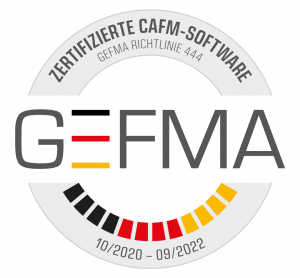
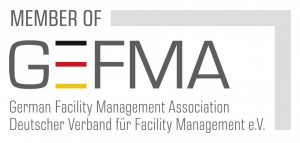
Die digitale Transformation ist mit Building Information Modeling (BIM), Internet of Things (IoT) oder Künstliche Intelligenz (KI) längst im Facility Management angekommen. Einerseits entwickeln sich FM-Software-Lösungen wie FAMOS stetig weiter, andererseits halten neue technische Innovationen Einzug ins FM. Dieser technische Fortschritt hat immensen Einfluss auf die Entwicklungen bspw. im Instandhaltungsmanagement, im Bau-Prozess, in der Bewirtschaftung oder für smartes Wohnen. Keßler Solutions engagiert sich deshalb seit vielen Jahren ehrenamtlich im Expertenteam des Arbeitskreises Digitalisierung (bis 2018 Arbeitskreis CAFM) und beteiligt sich u.a. aktiv am Ausbau der Richtlinien, am CAFM Trendreport und diversen White-Papers oder an Veranstaltungen, wie an der GEFMA-Präsenz auf der CAFM-Messe am 29. und 30. September 2020.
Der Berufsverband für Facility und Real Estate Manager in Deutschland, der RealFM e.V. Association for Real Estate and Facility Managers, hat mit den Verbänden Facility Management Austria und SVIT FM Schweiz das Positionspapier „Beitrag des Real Estate und Facility Managements zur Erreichung der Klimaschutzziele“ publiziert. Übersichtlich werden
Das Positionspapier führt am Ende erste Maßnahmen an. Die AutorInnen schließen mit: “Das Potenzial der Verringerung des Ressourcenverbrauchs im CREM und FM ist riesig. Lassen Sie es uns gemeinsam heben!”
Sie können es sich kostenfrei auf der Website des RealFM e.V. downloaden.
Geschäftsführer André Keßler ist Regionalkreisleiter Mitteldeutschland des Real FM e.V. und begrüßt die gemeinsame Initiative der DACH-Verbände. Er schließt sich den geplanten Aktivitäten, wie der Etablierung eines Maßnahmenmix für das Erreichen der Klimaschutzziele und der Aufnahme einer Nachhaltigkeitsstrategie auf Verbandsebene, uneingeschränkt an:
Das Team von Keßler Solutions konnte in den letzten Jahren eine erfolgreiche redaktionelle Zusammenarbeit mit mehreren Fachmagazinen etablieren. Im Ergebnis sind im 2. Quartal 2020 drei neue Artikel erschienen:
In der nur ein Mal jährlich erscheinenden Fachzeitschrift Integrale Planung. Nachhaltiges Bauen – Energieeffizientes Handeln berichtet Keßler Solutions auf vier Seiten über den Weg “Von der BIM-konformen Planung zum Smart Living” am Beispiel Future®Living Berlin (S. 92 – 95). Die Idee zum Artikel entstand im Rahmen der Nachbereitung der BIM world Munich 2019.
Zentrale Punkte des Beitrags:
Smart Living und die Digitalisierung im FM / BIM in sieben Dimensionen / Aktuelle Herausforderungen in der Praxis / Chancen von BIM und Smart Living für Bauherren, Betreiber und Nutzer
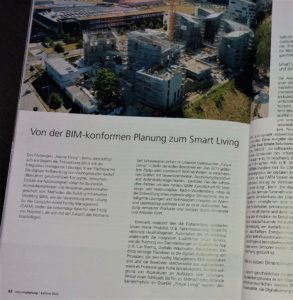
Hier gehts zur Ausgabe 2020 der “Integrale Planung” als e-paper (8,00€) und print (9,50€).
Teaser: Das Pilotprojekt Future Living® Berlin beschäftigt sich seit Beginn der Entwicklung 2013 mit der Integration intelligenter Lösungen in ein Stadtquartier. Die digitale Aufbereitung von Wohngebäuden bedarf dabei eines ganzheitlichen Konzeptes. Wirtschaftlichkeit wie Nachhaltigkeit sollen für Bauherren, Immobilienbetreiber wie Bewohner gleichermaßen gesichert sein. Methoden des BIM wie die Verwendung einer CAFM-Lösung bilden die notwendige Basis für den Erfolg von Projekten, die sich mit der Zukunft des Wohnens beschäftigen.
Der Artikel wurde am 6. Juli 2020 in gekürzter Form auf der News-Seite der Messe BIM world MUNICH veröffentlicht [JETZT LESEN.]!
Für die Sommer-Ausgabe des Fachmagazins Bauen aktuell. Building Information Modeling und Gebäudeautomation durfte Keßler Solutions nach dem Artikel “Mehrwerte schaffen” (Bauen Aktuell Winter 2019/ 2020, S.22) wieder einen redaktionellen Beitrag veröffentlichen! Dieses Mal geht es auf zwei Seiten über die Entwicklung “Vom Aktenberg zum digitalen Prozess” bei und mit einem der FAMOS-Kunden.
Teaser: Während der Umsetzungsphase von Bauprojekten ist es zwingend notwendig, einen kontinuierlichen und verlässlichen Überblick über die anfallenden Kosten zu haben, um Budgetüberschreitungen vorzubeugen. Gerade im Hinblick auf den verantwortungsvollen Umgang mit Haushaltsmitteln sind effektive Planung, realistische Kalkulation und eine Wirtschaftlichkeitsprüfung sowie ein durchgängiges Controlling der Bauprojekte unverzichtbar.
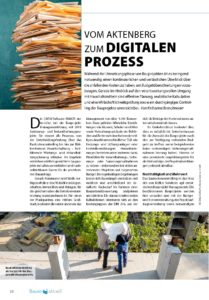
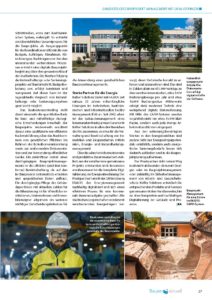
Hier gehts zur Sommer-Ausgabe 2020 der “Bauen Aktuell” als e-paper (kostenfrei).
Der WIN-Verlag, zu dem auch “Bauen aktuell” gehört, stellt derzeit interessierten LeserInnen die Ausgaben seiner aktuellen, sieben Fachmagazine als kostenfreie e-paper zur Verfügung! Das lohnt sich!
Link zum gesamten Verlagsprogramm.
In der vierten Ausgabe 2020 des AUTOCAD & Inventor Magazin konnten wir mit unserem Partner Gräbert GmbH vorstellen, wie digitale Prozesse im FM mit Web-CAD optimiert werden können.

Teaser: CAD-Systeme sind aus der Planung, Projektierung, Konstruktion und Bewirtschaftung von Im-mobilien längst nicht mehr wegzudenken. Die 2D- Darstellung eines Gebäudes – egal ob bei Büro-, Wohn-, Industrie- oder öffentliche Flächen – bietet ein detailgetreues optisches Modell von der Steckdose bis zur Brandschutzklappe, von der Reinigungsfläche bis zum Dach. Während der Betriebsphase entstehen zahlreiche Vorteile, wenn man CAD-Daten systematisch und bestenfalls mobil nutzen kann, zum Beispiel über eine CAFM-Software wie Famos von Keßler Solutions.
Hier gehts zur Ausgabe 4/ 2020 des “AUTOCAD & Inventor Magazin” als e-paper (kostenfrei).
Der WIN-Verlag, zu dem auch das “AUTOCAD & Inventor Magazin” gehört, stellt derzeit interessierten LeserInnen die Ausgaben seiner aktuellen, sieben Fachmagazine als kostenfreie e-paper zur Verfügung! Das lohnt sich!
Link zum gesamten Verlagsprogramm.
Das Coronavirus (SARS-CoV-2) breitet sich zunehmend in Deutschland aus. Das Risiko für die Bevölkerung wird von Experten aktuell für die meisten Regionen zwar weiterhin als mäßig eingeschätzt, aber es wird auch auf Gefahren einer möglichen Pandemie hingewiesen. Da die Gesundheit und Sicherheit der Menschen im Mittelpunkt stehen, werden aktuell verschiedenste Maßnahmen ergriffen. Für viele Kunden, Interessenten und Partner von Keßler Solutions (im Folgenden zusammengefasst als Partner) bestehen bereits Reise- und Kontaktrestriktionen, Tendenz steigend. Sorgfältig geplante, wichtige Termine und Aktivitäten mit unserem Haus sind ggf. bereits davon betroffen.
Keßler Solutions wird diese Einschränkungen ausgleichen und reagiert auf die Situation mit einer Erweiterung des Angebots für digitale Kommunikation. Zusätzliche Arbeitsplätze für Schulungen und Fernzugriffe sind geschaffen. Ergänzend wird ein neues Videokonferenz-System eingerichtet. Im Sinne aller Partner und selbstverständlich der eigenen Mitarbeiter/innen stehen diese Möglichkeiten ab sofort zur Verfügung.
Ganz nach dem Motto “Alles Schlechte hat auch etwas Gutes” wird Keßler Solutions die aktuelle Situation zum Anlass nehmen und auch langfristig auf die digitalen Kommunikationswege setzen. Damit kommt das Unternehmen den für sich selbst und die Partner formulierten Zielen wieder einen Schritt näher:
Bitte beachten Sie, dass aufgrund der Arbeit im Home Office manche MitarbeiterInnen nicht über Ihr Büro-Telefon erreichbar sind. Schreiben Sie im Bedarfsfall bitte eine E-Mail.
Informieren Sie sich bei Unsicherheit gern direkt bei Ihrer/m Ansprechpartner/in über die (Neu-)Organisation Ihrer anstehenden oder bisher noch ungeplanten Termine.
In den kommenden Wochen erhalten Sie in diesem Beitrag Updates zum Thema Digitale Kommunikation, z.B. zu den technischen Anforderungen.
UPDATE: 1. Digitales FAMOS User Forum im Mai & Juni 2020! (HIER KLICKEN)
Vielen Dank für Ihr Interesse am 19. FAMOS User Forum. Gern würde Sie das Team von Keßler Solutions zu Tagung und Schulungen wie gewohnt im Frühjahr in Leipzig begrüßen. Aber wie viele von Ihnen sicher schon vermuten, haben wir von Keßler Solutions in den vergangenen Tagen intensiv über die Termine im April 2020 und die Verbreitung des Coronavirus nachgedacht. So bestehen für viele Kunden und Partner bereits Reise- und Kontaktrestriktionen.
Im Sinne der Gesundheit unserer Kund/innen und Partner/innen und selbstverständlich der eigenen Mitarbeiter/innen vertagen wird deshalb (schweren Herzens) das FAMOS User Forum auf voraussichtlich September oder Oktober 2020. Bitte stornieren Sie in diesem Zusammenhang rechtzeitig gebuchte Übernachtungen und Fahrten.
Bitte beachten Sie auch die Informationen zur Angebotserweiterung der Digitalen Kommunikation mit Keßler Solutions!
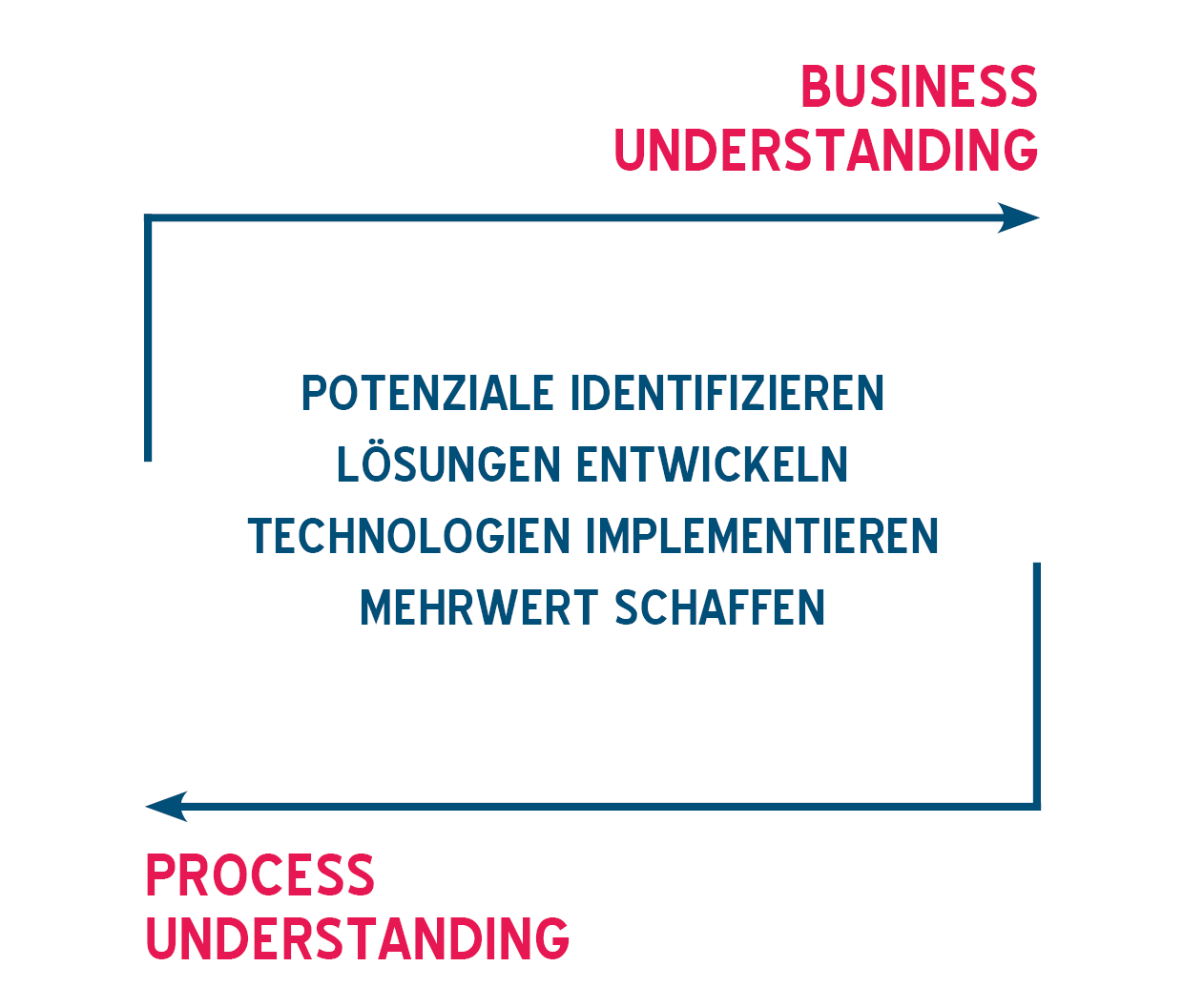
Die jährliche Plattform für den Austausch von Innovationen, Erfahrungen und Ideen zwischen FAMOS-Anwendern, -Auftraggebern und unseren Experten bietet News, Tipps & Perspektiven rund um FAMOS, Beratungsmöglichkeiten vor Ort an unseren Ständen sowie viele Möglichkeiten für persönliche Gespräche, Erfahrungs- und Wissensaustausch mit anderen Kunden, Anwendern und unseren FAMOS-Experten. Die Themen 2020:
Die Tagung wird traditionell umrahmt von zwei praxisorientierten Tagen, die FAMOS-Anwendern die Möglichkeit geben, ihr Wissen und ihre Fertigkeiten im Umgang mit FAMOS zu erweitern und sich mit anderen Nutzern und den Ansprechpartnern von Keßler Solutions auszutauschen.
Schulung am Mittwoch, 22. April:
Adminschulung am Freitag, 24. April:
Dialog- und Projekttag am Freitag, 24. April:
Bitte beachten Sie, dass die Kapazitäten für die Schulungen wie für den Dialog- und Projekttag begrenzt sind und melden sich rechtzeitig an, vielen Dank!
Für mehr Informationen und Anmeldung schreiben Sie bitte eine Mail an kbretschneider[a]kesslersolutions[.]de
Öffentliche Institutionen und Unternehmen sehen sich der wiederkehrenden Aufgabe gegenübergestellt, für die Betriebsbereitschaft und Absicherung ihrer Gebäude und Anlagen zu sorgen. Prioritäten für Instandhaltungs-, Sicherungs- oder Sanierungsmaßnahmen zu setzen, fällt teils schwer – insbesondere wenn es eine hohe Anzahl anstehender Projekte bei begrenztem Budget gibt. Die CAFM-Software FAMOS unterstützt mit der Bauprojekt-Managementlösung seit 2019 Sanierungs- und Instandhaltungsprojekte. Diese steuert alle Prozesse von der verifizierten Entscheidungsfindung über das Baukostencontrolling bis zur (BIM-konformen) Bewirtschaftung inklusive fortführender Wartungs-/ Instandhaltungsplanung.
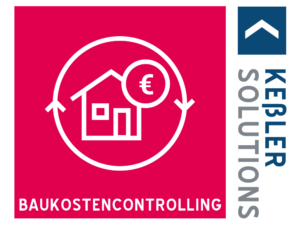
Gestartet wird mit der Bauzustandsbewertung vor Ort durch qualifizierte MitarbeiterInnen von Keßler Solutions. Dies geschieht zum Beispiel durch eine Erfassung, Strukturierung und Digitalisierung der notwendigen Flächen-, Bauwerks- und Anlagendaten sowie der Baubedarfe. Auf Basis der erstellten digitalen Bauzustandsbewertung werden die Instandhaltungs- oder Sanierungsprojekte verglichen und gewichtet. Dies beinhaltet u.a. Kalkulationen, die sich an den Kostengruppen der DIN 276 orientieren. Im Ergebnis entstehen priorisierte Empfehlungen für die Reihenfolge der Projektabwicklung.
Für öffentliche Institutionen bietet Keßler Solutions zusätzliche Hilfestellungen an; so für die Formulierung klassifizierter Entscheidungs- bzw. (Gremien-)Beschlussvorlage für einen Baubedarfsantrag oder die begleitende Beratung während des Vergabeprozess.
Im CAFM-System FAMOS werden die Baubedarfe vom Antrag bis zum Beschluss abgebildet. Die beschlossenen Bauprojekte werden verwaltet und mit bspw. der Budget- und Kostenverwaltung, der Projektauftragsverwaltung sowie notwendigen Schnittstellen, z.B. zum ERP-System, verknüpft. So entsteht ein übersichtlicher Workflow für das Baukostencontrolling: Projekte, Budgets, Aufträge, Abnahmen, Abrechnungen, Nachträge usw. können einfach und tagesaktuell koordiniert werden. Aus den verknüpften Prozessen entsteht eine digitale Bauprojektbegleitung über den gesamten Bauablauf. Die Kontrolle der Instandhaltungs- oder Sanierungsprojekte auf Baufortschritt, Budgetbelastung usw. erfolgt konsistent und transparent.
Das „digitale Bauprojekt“ stellt durch die systematisch erfassten und gespeicherten Daten und Prozesse u.a. die Basis für das Nachkommen von gesetzlichen Pflichten im Rahmen der Betreiberverantwortung oder zur Dokumentation (z.B. Standard IFRS 16). Die geschaffene Datenbasis bietet einen entscheidenden Mehrwert u.a. für die effiziente, nachhaltige und BIM-konforme Objekt-Bewirtschaftung und die laufende Wartungs- und Instandhaltungsplanung. Für Neubauten oder als Informationsbasis für einen Rückbau hält die CAFM-Lösung weitere wesentliche Werkzeuge bereit. Die durchgängige Pflege des Gebäudeportfolios mit aktuellen Zahlen für die Bilanzierung ist ein weiteres wichtiges Entscheidungskriterium für den ganzheitlichen Ansatz von Keßler Solutions.
Verantwortungsträger müssen und dürfen bei der Priorisierung und Durchführung von Bauprojekten aller Art nicht nur den Kostenfaktor der Maßnahmen und gesetzliche Anforderungen betrachten: Die Betreiberverantwortung inkl. Arbeits- und Gesundheitsschutz geht für verantwortungsvolle Vermieter, Arbeitgeber und Immobilienbesitzer über die gesetzlichen Mindestanforderungen hinaus.
„Das gesellschaftliche und politische Interesse an Themen wie Nachhaltigkeit und Digitalisierung wächst stetig, daher wird der Druck durch externe, bisher nicht entscheidungsrelevante Faktoren auf Entscheidungen ebenso größer.“, so Geschäftsführer André Keßler.
Letztlich ist eine aktive Beteiligung an der sogenannten digitalen Transformation notwendig, um konkurrenzfähig zu bleiben und zukunftsfähig zu werden (Schlagworte wie BIM-konformer Betrieb oder Lean Construction sind hier gegenwärtig). Eine schrittweise, aber langfristig umfassende Daten- und Prozessdigitalisierung unterstützt Institutionen und Unternehmen dabei, die technologischen, gesellschaftlichen und wirtschaftlichen Herausforderungen nachhaltig zu meistern. Als erfahrener und digital versierter Partner unterstützt Sie Keßler Solutions dabei.
(4.468 Zeichen inkl. Überschrift & Leerzeichen)
Aktuelles zum Bauprojekt-Management erfahren Sie auf der Website zum Thema.
Im Downloadbereich finden Sie den kostenfreien A4-Flyer “Digitales Bauprojekt”.
Melden Sie sich bei Interesse zum Webinar “Das digitale Bauprojekt” an (kostenfrei).
Im Jahr 2018 beging der GEFMA Arbeitskreis CAFM nicht nur sein 10-jähriges Bestehen, sondern wurde dem Zeitgeist entsprechend in Arbeitskreis Digitalisierung umbenannt. Die neue Namensgebung verdeutlicht, dass die digitale Transformation im Facility Management längst angekommen ist. Einerseits entwickeln sich FM-Software-Lösungen wie FAMOS stetig weiter, andererseits halten neue technische Innovationen wie Building Information Modeling (BIM), Internet of Things (IoT) oder Künstliche Intelligenz (KI) Einzug ins FM. Dieser technische Fortschritt hat immensen Einfluss auf die Entwicklungen bspw. im Instandhaltungsmanagement, im Bau-Prozess, in der Bewirtschaftung oder für smartes Wohnen.
Keßler Solutions engagiert sich seit vielen Jahren ehrenamtlich im Expertenteam des Arbeitskreises, arbeitet u.a. aktiv am CAFM Trendreport mit oder zuletzt an der Aktualisierung des BIM White Paper (veröffentlicht im Januar 2020). Am 5. März 2020 sind Vertreter von Keßler Solutions selbstverständlich auch beim 5. CAFM-Herstellertreffen der GEFMA in Bonn dabei. Themen sind u.a. Trends und Zukunftsaussichten im CAFM sowie die Erweiterung der Zertifizierungsrichtlinie 444 um die Kriterienkataloge Vertragsmanagement und Workplace Management. Die Rezertifizierung nach der GEFMA Richtlinie 444 inkl. der neuen Kataloge ist in der Jahresmitte ein zentrales Thema bei Keßler Solutions.
Nachtrag 1: Zum Herstellertreffen hat die GEFMA den Nachbericht “Quo vadis – CAFM? Die Zukunft des CAFM oder hat das CAFM Zukunft?” veröffentlicht.
Nachtrag 2: Erfolgreiche Re-Zertifizierung der CAFM-Softwarelösung FAMOS in der Version 4.5 am 23. September 2020!

In der neuen Ausgabe der “Bauen Aktuell – Building Information Modeling und Gebäudeautomation” (Winter 2019/2020) findet sich ein redaktioneller Beitrag zu Gesamtstrategien im BIM und “Mehrwerte schaffen” von Geschäftsführer André Keßler.
“Ressourcenoptimiertes Bauen wird zunehmend Pflicht. Die im gleichen Atemzug benannten Schlagworte sind Kosteneffizienz, Rechtssicherheit und Innovativität. Building Information Modeling (BIM) ist ein Weg, alle diese Ziele zu erreichen. (…) Um diese[n] erfolgreich umzusetzen, bedarf es eines komplexen Zusammenspiels aus CAFM- und BIM-Prozessen. (…) Bereits in kleinen Optimierungen auf dem Weg zur Digitalisierung liegen viele versteckte Ressourcen, die gefunden werden wollen.”
Den gesamten Artikel finden Sie in der Ausgabe von “Bauen Aktuell” (mehr Infos). Diese liegt übrigens auch auf der ersten digitalBAU im Februar in Köln aus!
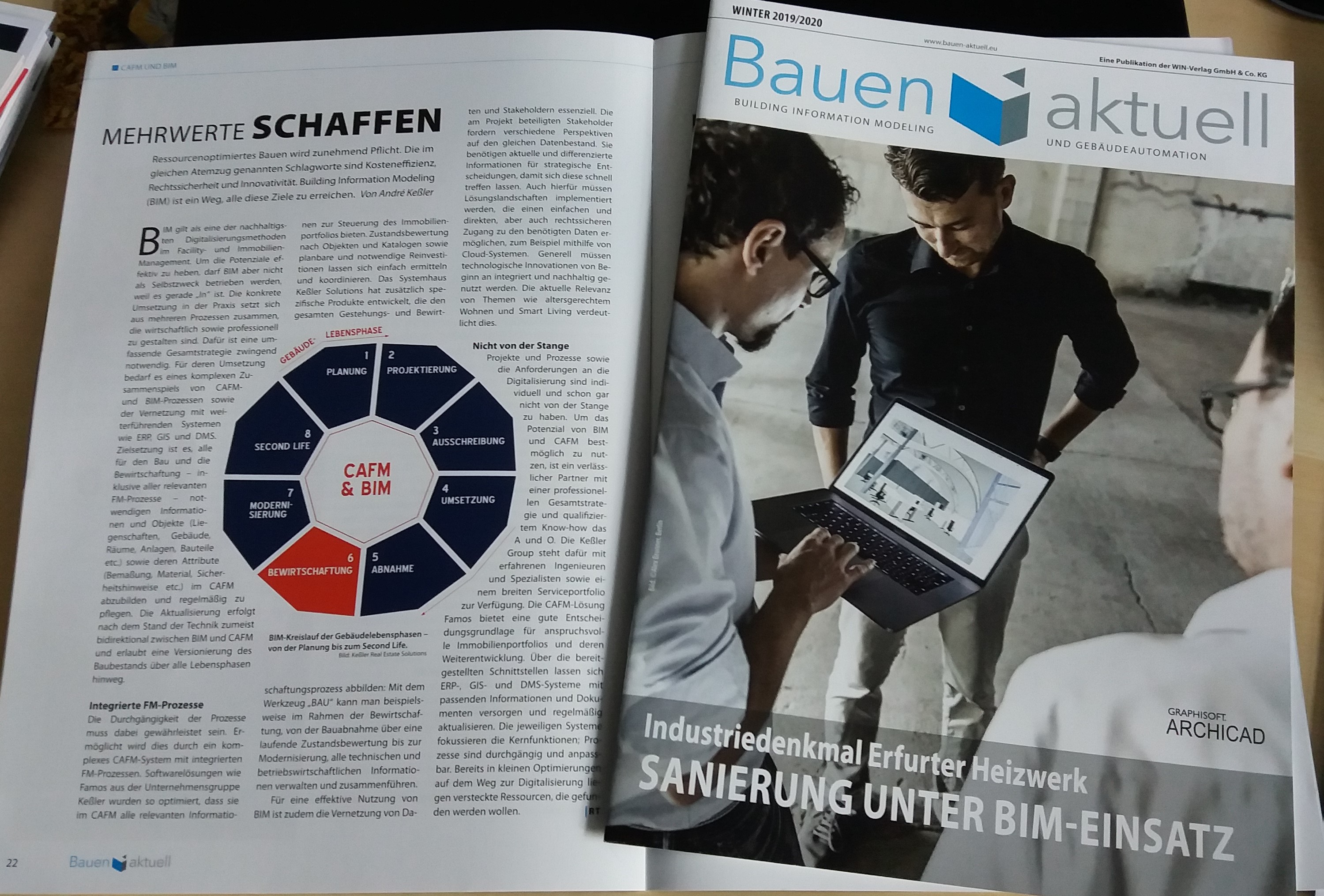
Keßler Solutions bemühte sich 2019 erneut verstärkt um Aufklärung zum Thema Digitalisierung im Allgemeinen und um Beförderung Digitaler Technologien wie Smart Services oder KI (Künstliche Intelligenz) im Besonderen. Mit Partnern wie bspw. der GSW Sigmaringen und der Friedrich-Alexander Universität (FAU) Erlangen-Nürnberg nahmen so die Projekte Future Living® Berlin und ForeSight in den Bereichen Smart Living und KI Fahrt auf.
„Das moderne, ‚intelligente‘ Wohnen umfasst zukünftig neben der normalen Miete die Integration angenehmer, praktischer oder lebenswichtiger Dienstleistungen. So ermöglichen Smarte Wohnungen und Quartiere vielen Menschen ein selbstbestimmtes Leben in den eigenen vier Wänden.“, so André Keßler, Geschäftsführer von Keßler Solutions. „Die Projekte Future Living® Berlin und ForeSight geben uns die Chance, aktiv am digitalen Wandel der Lebenswelt teilzuhaben. Gemeinsam mit zahlreichen starken Partnern stellen wir eine ressourcenoptimierte wie nachhaltige Umsetzung der Projekte sicher.“
Im Mai konnte mit dem Wohnprojekt der GSW-Sigmaringen Future Living® Berlin der Gewinn eines SmartHome Deutschland Award verzeichnet werden. Die Jury wählte das Projekt und „sein tolles Partnernetzwerk“ in der Kategorie „Beste realisierte Projekte“ auf den dritten Platz. Im Oktober erhielt die GSW zudem für die Präventions- und Sicherheitskonzepte für „ein nachhaltiges und digitalisiertes Zuhause“ den DEKRA Award „Sicherheit zu Hause“.
Das Partnernetzwerk bewarb sich im Frühjahr erfolgreich mit „ForeSight: Plattform für kontextsensitive, intelligente und vorausschauende Smart Living-Services“ beim Innovationswettbewerb „Künstliche Intelligenz als Treiber für volkswirtschaftlich relevante Ökosysteme“ des Bundesministeriums für Wirtschaft und Energie. Ein Poster und ein Short Paper zu „ForeSight – Platform Approach for Enabling AI-based Services for Smart Living“ von Jochen Bauer, Hilko Hoffmann et.al. wurde für die internationale ICost-Konferenz im Oktober in New York City ausgewählt. Die Internationale Konferenz zu Smart Living und Öffentlicher Gesundheit (International Conference On Smart Living and Public Health) ICOST ist eine wichtige Plattform zur Diskussion rund um das Thema KI im Gesundheitswesen (z. B. E-Health), u.a. in Bezug zu Smart Citys (z. B. AAL).
GSW Sigmaringen, FAU Erlangen-Nürnberg, Keßler Solutions und alle weiteren Partner freuen sich auf die Weiterentwicklung der Projekte in 2020: Ab Februar ziehen die ersten Bewohner in das Quartier Future Living® Berlin ein, das mit der CAFM-Software FAMOS aus dem Haus Keßler Solutions bewirtschaftet wird. Im Frühjahr startet ForeSight als eines von 16 Konsortien in die dreijährige Umsetzungsphase des Innovationswettbewerbes.
„Wir sind natürlich sehr froh, dass unsere Partner und wir mit dem ForeSight-Konzept überzeugen konnten und nun die Chance haben, beim vermutlich größten Smart-Living-Projekt der nächsten zehn Jahre in Deutschland mitwirken zu dürfen.“, so Jochen Bauer vom Lehrstuhl für Fertigungsautomatisierung und Produktionssystematik an der FAU. „Am Ende der Projektlaufzeit rechnen wir mit einer Methodenplattform, die über zahlreiche robuste Module verfügt und in den Bereichen Interoperabilität, Security, Datenschutz und natürlich KI neue Maßstäbe setzen wird.“
Bekanntermaßen ist die Mission von Keßler Solutions die Digitalisierung und Automatisierung von Daten und Prozessen. Dies beinhaltet bspw. die effektive Datenerfassung und -verarbeitung, professionelle Beratung zur und Begleitung der Prozessoptimierung, die Umsetzung von Innovationen für zahlreiche namhafte Kunden verschiedenster Branchen sowie Investitionen in digitale Zukunftstechnologien, u.a. im Bereich Smart Living. Keßler Solutions betrachtet Smart Products und Smart Services nicht nur als angenehmen oder „hippen“ Lifestyle. Das Hauptaugenmerk liegt auf den großen Potentialen für ein barrierefreies und altersgerechtes Leben. Am Projekt Future Living® Berlin arbeiten das Unternehmen deshalb aktiv an der Lösung für die Vermietung intelligent ausgestatteter Wohnungen mit. Dafür wird die hauseigene Software FAMOS zur Verfügung gestellt. Mittels FAMOS lassen sich die neuen Services einfach integrieren und transparent abrechnen. Die Prozesslösungen bieten für Vermieter wie Mieter alle Vorteile einer effizienten Vernetzung, wie die bedarfsgerechte Nutzung, unkompliziertes Störungs- und Wartungsmanagement, übersichtliches Controlling durch eine ganzheitliche Dokumentation usw.
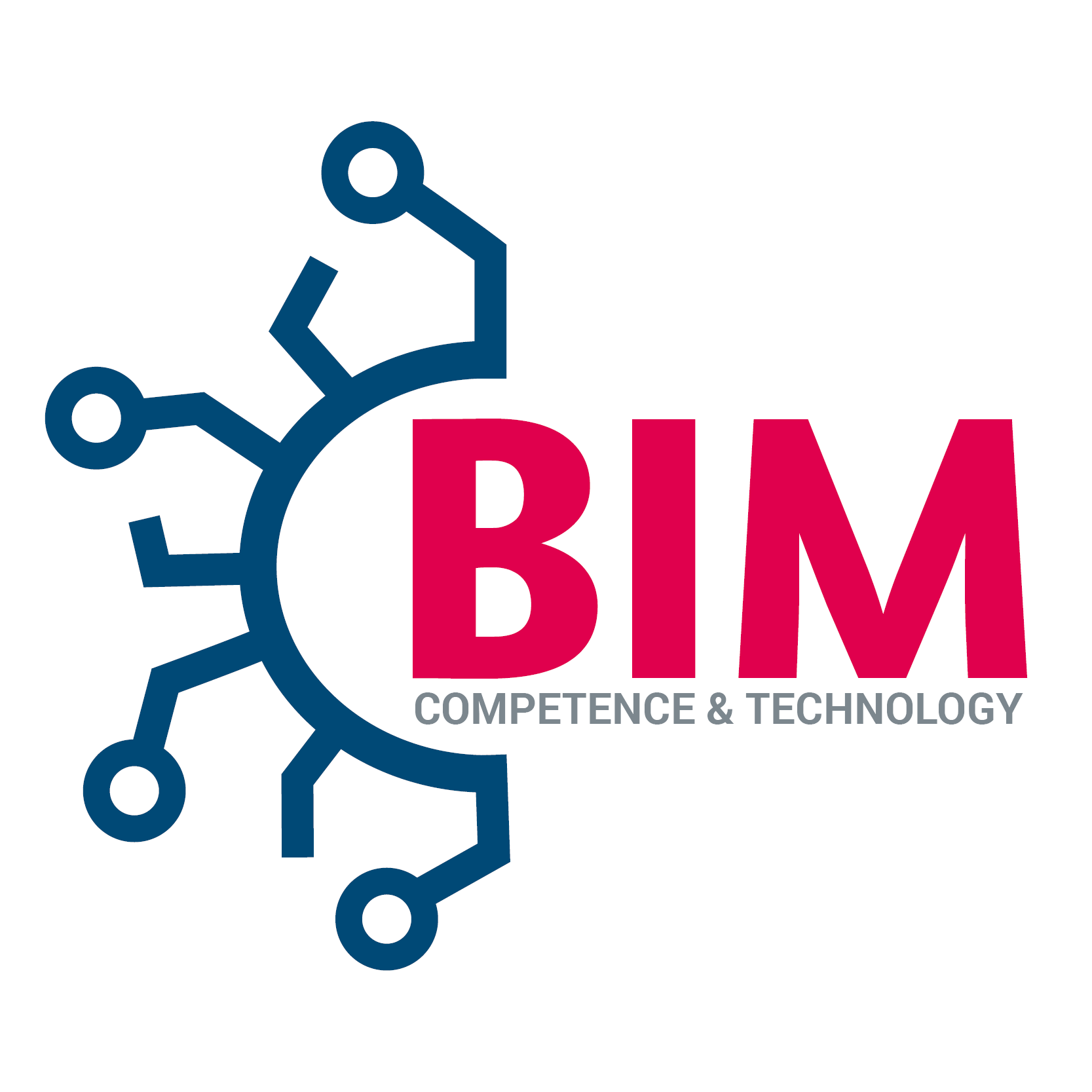 Das Ende 2018 von der Keßler Group initiierte BIM-Kompetenz- und Technologiezentrum blickt auf ein erfolgreiches erstes Arbeitsjahr zurück: Zwei öffentliche Fachgespräche im Mai und September, Teilnahme an der BIM world MUNICH sowie die Präsentation der technologische Roadmap im November. Auf der neuen Website https://www.bim-technologie.de können Interessierte die ersten erarbeiteten Projektansätze einsehen sowie Informationen zur aktiven Mitarbeit anfordern.
Das Ende 2018 von der Keßler Group initiierte BIM-Kompetenz- und Technologiezentrum blickt auf ein erfolgreiches erstes Arbeitsjahr zurück: Zwei öffentliche Fachgespräche im Mai und September, Teilnahme an der BIM world MUNICH sowie die Präsentation der technologische Roadmap im November. Auf der neuen Website https://www.bim-technologie.de können Interessierte die ersten erarbeiteten Projektansätze einsehen sowie Informationen zur aktiven Mitarbeit anfordern.
Die Projektansätze greifen Problemstellungen aus der Praxis auf und skizzieren dafür innovative Lösungsideen. Beispielsweise soll ein Assistenzsystem für Wartungs- und Reparaturarbeiten entwickelt werden. Dafür werden Methoden und Werkzeuge zur Planung von Bauwerken, zur Identifizierung und Auswahl von technischen Komponenten sowie zur Positionsbestimmung und Navigation im Bauwerk entwickelt. Die ersten Projektanträge werden im Rahmen des Zentralen Innovationsprogramms Mittelstand (ZIM) noch im Dezember gestellt:
Für Februar 2020 ist das nächste Fachgespräch an der Universität Leipzig geplant, auf dem Bauunternehmen ihre Erfahrungen aus der praktischen Anwendung und ihre Erwartungen an BIM vorstellen werden. Der öffentliche Event bietet Unternehmen und Wissenschaftlern die Möglichkeit, aktuelle technische Entwicklungen, Trends und For-schungsfragestellungen zu diskutieren.
Das Netzwerk aus Unternehmen und Hochschulen forciert gemeinsame Forschungs- und Entwicklungsprojekte im thematischen Umfeld des “Building Information Modeling” (BIM). Bereits ein Dutzend Partner beschäftigen sich mit Fragestellungen zu technischen Grenzen, Anforderungen an die Infrastruktur, BIM-relevanten Gesetzen und Normen, zukünftigen Geschäftsmodellen und weiterem mehr. Ziele des BIM-Kompetenz- und Technologiezentrums sind u.a. eine praktische wie praktikable Umsetzung und nachhaltige Anwendung des BIM. Die Einbeziehung betroffener Stakeholder ermöglicht das Identifizieren von offenen Punkten im Immobilienlebenszyklus sowie das schnelle Auffinden von Synergiepotentialen. Das Netzwerk ist offen für weitere Partner, die an einer aktiven Mitarbeit interessiert sind.
Erfahren Sie im Blogbeitrag mehr zur Bedeutung von BIM für die Geschäftsprozessdigitalisierung und die zahlreichen Vorteile des Building Information Modeling!
Zum Beitrag.
Besuchen Sie den Downloadbereich und laden Sie sich den Folder “BIM – Building Information Modeling” und weitere kostenfreien Unterlagen herunter.
Zum Downloadcenter.
Lesen Sie ergänzend den Fachbeitrag “Energieeffizienz und smarte Bewirtschaftung durch BIM” im Fachmagazins „Computer Spezial. Digitalisierung im Bauwesen“ (2/19).
Zum Beitrag.
Traditionell im Frühjahr lädt das Team von Keßler Solutions zum FAMOS User Forum nach Leipzig ein. Die Tagung am 23. April 2020 findet wie bereits 2018 im pentahotel Leipzig statt. Als roter Faden des 19. FAMOS User Forum ist das Thema „Herausforderungen der Prozessoptimierung“ gesetzt. Die Tagung wird traditionell umrahmt von zwei praxisorientierten Tagen, die den TeilnehmerInnen die Möglichkeit geben, Wissen und Fertigkeiten im Umgang mit FAMOS zu erweitern und sich mit anderen Nutzern und Ansprechpartnern von Keßler Solutions auszutauschen.
Die jährliche Plattform für den Austausch von Innovationen, Erfahrungen und Ideen zwischen FAMOS-Anwendern, -Auftraggebern und unseren Experten bietet auch 2020:
Sie möchten sich am Programm mit einem Redebeitrag, einem Stand oder einer Aktion beteiligen? Sie haben Themenwünsche/ Vorschläge/ Anregungen für den interaktiven Teil? Sie möchten Informationen zur Anmeldung erhalten, dann schreiben Sie bitte eine Mail, danke!
Nutzen Sie die zusätzlichen Möglichkeiten für persönliche Gespräche mit Ihren FAMOS-Experten. Klären Sie Nachfragen zu den Themen des FAMOS User Forums oder zu Ihren projektspezifischen Modulen und Prozessen direkt mit uns vor Ort. Ob als Workshoptag oder als Kurzmeeting oder einfach, um Ihre Projektbetreuer und -entwickler einmal persönlich kennen zu lernen – sprechen Sie uns gern auf Ihren Termin an!
Falls Sie am Mittwoch, 22. April, nicht an der Schulung teilnehmen, können Sie bereits an diesem Tag Termine bei Keßler Solutions wahrnehmen.
Bitte wenden Sie sich rechtzeitig an Ihre/n ProjektleiterIn und besprechen mit ihm/ ihr die Details, da nur begrenzte Terminfenster zur Verfügung stehen.
Für die Ausgabe 2/ 2019 des Fachmagazins Computer Spezial. Digitalisierung im Bauwesen wurde Keßler Solutions um einen Beitrag zum Thema BIM-Zukunft energieeffizienter Gebäude gebeten. Im in der Printausgabe sowie online erschienenen Artikel kann gelesen werden, welche Vorteile Building Information Modelling für eine bessere Energieperformance von Gebäuden bringt.
Geschäftsführer André Keßler führt u.a. aus, wie die Erweiterung um den Einsatz digitaler/ smarter Technologien, ein vielseitiges CAFM-System wie FAMOS und ein ganzheitliches Konzept, die Energieverbräuche sowie Prozessabläufe allgemein, noch weiter optimieren kann.
Als Praxisbeispiel dient das Berliner Mietwohnbrojekt FUTURE LIVING® der GSW-Sigmaringen.
(Grafik anklickbar)
Zur Website „Energiemanagement“ mit Infos zum Energiemanagementsystem und Energieeffizienz.
Sie möchten mehr erfahren? Dann melden Sie sich zum Webinar „Energiemanagement mit FAMOS” an (kostenfrei).
Für Verwaltungen und Kommunen gibt es zusätzlich das Webinar “Kommunales Energiemanagement” (kostenfrei).
NACHTRAG 16.03.2020 – Artikel
Gebäude sind für über 40 Prozent des weltweiten Energieverbrauchs und für einen Großteil des CO2-Ausstoßes verantwortlich. Die Betriebskosten von Gebäuden betragen ca. 80 Prozent der Gesamtkosten über den gesamten Lebenszyklus. Die effiziente Planung sowie die automatisierte Kontrolle und Steuerung von z.B. Licht, Lüftung, Heizung und Sicherheitssystemen sind daher einer der wichtigsten Hebel zur Kostensenkung. Aus Digitalisierung, technischer Optimierung und der Integration von BIM in das Gebäudemanagement ergeben sich weitere Vorteile:
„Auf Grund des technologischen Fortschrittes und der damit verbundenen Möglichkeit der Einbindung von Sensoren, deren intelligenten Auswertung sowie der daraus resultierenden Steuerung von Aktoren, werden Gebäude, vor allem im Verbund mit- und zueinander, künftig zu dynamisch reagierenden Ökosystemen. Diese reagieren sowohl auf ihre inneren Einflüsse als auch auf ihre Umwelt und können somit ihre Vorteile langfristig ausspielen. Ein Beispiel ist die optimale Abstimmung der Umgebung in Bezug auf z.B. Licht, Luftqualität, Temperatur und Feuchtigkeit.“, erklärt Geschäftsführer André Keßler der Keßler Real Estate Solutions GmbH.
Sensoren, Aktoren u.ä. liefern als „Smart Grids“ (intelligente Verteilnetze) wertvolle Daten und Informationen in den sogenannten Digitalen Zwilling, der es erlaubt, den CAFM-konformen Betrieb sicherzustellen. Durch intelligente Auswertung bspw. mittels integrierter CAFM-Prozesse können die Datenmengen – bei Bedarf in Echtzeit – zu aussagefähigen Kennzahlen werden. Algorithmen werten Gebäude- und Nutzungsverhalten aus und erkennen Muster in der Anwendung oder im Verbrauch einzelner Anlagen. Bezugsdaten werden so aufbereitet, dass sie für Investoren und Bauträger mit anderen Immobilienbeständen vergleichbar und bewertbar werden.
„Damit entstehen aus digital erhobenen Daten relevante Entscheidungsgrundlagen, welche zu vorausschauenden Strategien und einer kontinuierlichen Optimierung führen, bis hin zu Zero Net Energy Buildings.“, so André Keßler weiter.
Auch Verbraucher werden so für das Energiesparen sensibilisiert, denn die neuen oder verbesserten Analysemöglichkeiten machen Energieverbräuche transparenter und effizienter steuerbar.
Um die Vorteile der smarten, energieeffizienten Bewirtschaftung bestmöglich zu nutzen, sind die Integration eines ganzheitlichen BIM-Konzeptes bereits in der Planungsphase (eines Neubaus oder einer Modernisierung) sowie die Gewährleistung durchgängiger Prozesse notwendig. Auch wenn in der Bau-Umsetzung mittels einer digitalen Bauwerksakte zunächst mehr Aufwand in der Errichtungsphase entsteht, so tragen die erzielten Prozessoptimierungen, Energieeffizienzmaßnahmen, Möglichkeiten vorbeugender Instandhaltung, Vernetzung & Automatisierung durch Smarte Technologien usf. langfristig zur Wettbewerbsfähigkeit am Markt bei.
Durch diese Maßnahmen und dank eines vielseitigen CAFM-Systems wie FAMOS aus dem Haus Keßler ist es möglich, die Bewirtschaftungskosten und damit die Energieeffizienz dauerhaft zu überwachen und kontinuierlich zu optimieren.
Keßler Solutions setzt mit seinen CAFM-Lösungen dabei bewusst auf die Integration aller Gebäudelebensphasen in ein Gesamtmodell, das zukünftig analoge wie smarte Services kombiniert. Dies versetzt Bauträger und Investoren in die Lage, nicht nur Einnahmen aus Mieten, sondern auch als Provider ergänzender Services zu generieren.
Die GSW Sigmaringen baut aktuell das Mietwohnprojekt Future Living® Berlin. unterstützt von einem Partner-Netzwerk, zu welchem Keßler zählt. Das entstehende Quartier versorgt sich energetisch selbst: Zum Energiekonzept gehören PV-Anlagen auf optimal ausgerichteten Dächern, deren Strom u.a. 17 Luft-Wärme-Pumpen bedient, Sole-Wärme-Pumpen zur Rückgewinnung von Wärme aus der Abluft der Wohnungen, ein großer Batterie- und verschiedene Wärme- und Kältespeicher. In das Energiekonzept sind gemanagte Ladesäulen für e-Autos eingebunden. Future Living® Berlin ist ein Vorzeigeprojekt für die phasenübergreifende, prozessdurchgängige BIM-Integration sowie für die Entstehung nachhaltiger, smarter Stadtquartiere mit Gemeinschafts-, Wirtschafts- und Wohnflächen. Das Partner-Netzwerk setzt – angefangen beim Anlagenmanagement bis über mobile Devices buchbare Services wie Car Sharing – auf ein ganzheitliches Energiekonzept.
Die CAFM-Lösung FAMOS unterstützt Future Living® Berlin aktiv mit einer offenen Plattform verschiedener (Web-)Services, auch von Drittanbietern, und stellt damit einen einzigartigen Werkzeugkasten für die digitale Bewirtschaftung und Dokumentation zur Verfügung.
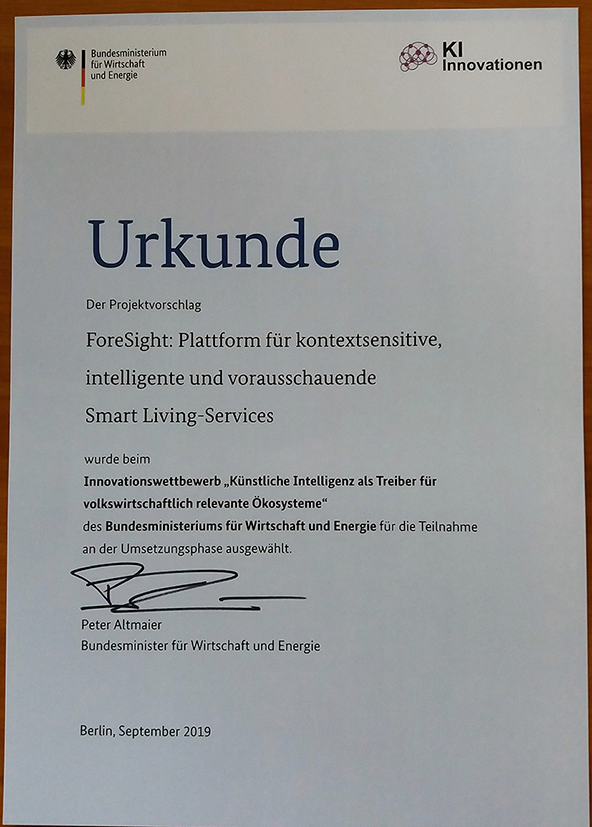
Jochen Bauer vom Lehrstuhl Fertigungsautomatisierung und Produktionssystematik der FAU Erlangen-Nürnberg wurde über das Gemeinschaftsprojekt „ForeSight“, bei dem sich Keßler Solutions aktiv beteiligt, von der Pressestelle seiner Universität interviewt.
Er erklärt unter anderem, wie KI (Künstliche Intelligenz) dabei helfen kann, Menschen in ihren Wohnungen zu unterstützen und Häuser wirtschaftlich zu betreiben.
Das Interview gibt einen wirklich guten und konkreten Überblick über das von der GSW Sigmaringen initiierte Projekt: INTERVIEW LESEN.
Weitere Beiträge zum Thema auf unserer Website:
![]()
Die Anforderungen an die Verantwortlichen im Mietmanagement steigen ständig. Die Keßler-Prozesslösung für ein einfaches und effizientes Mietmanagement unterstützt Sie dabei, Potenziale zu erkennen, Kosten- und Verwaltungsaufwände zu senken und die Qualität Ihres Mietmanagements deutlich und nachhaltig zu optimieren. Automatisieren Sie Ihre Mietobjektverwaltung vom Vertragsmanagement bis zur konfektionsfertigen und verursachergerechten Abrechnung.
Im neuen neuen Datenblatt erhalten Sie einen schnellen und konkreten Überblick üder die Inhalte und Vorteile des Prozesses sowie zu den Kombinationsmöglichkeiten mit anderen FAMOS-Modulen. Hier beispielhaft ein paar wichtige Punkte, Details dann HIER im zweiseitigen pdf:
Weitere Datenblätter, Broschüren und mehr finden Sie im Downloadcenter.
Im März diesen Jahres veröffentlichten wir die PM “Keßler Solutions baut mit XEOS Portfolio und Internationalisierung weiter aus” und stellten unsere Arbeit (TGA-Erfassung, QR-Code-Labeling) und die gemeinsamen Pläne mit XEOS (papierlose Verwaltung, automatisierte Lagerverwaltung) vor.
Nun verkündeten die Muttergesellschaften Lufthansa Technik und GE Aviation in einer Pressemitteilung vom 30. September, dass nach einer Rekordbauzeit von 16 Monaten das neue Instandhaltungszentrum für Triebwerke feierlich eröffnet wurde! Hochrangige Vertreter aus Polen, Deutschland und den USA nahmen am “Grand Opening” teil.
Dr. Johannes Bussmann, CEO der Lufthansa Technik, ist stolz auf das Geschaffte und das Engagement aller Partner und bedankte sich besonders beim gesamten XEOS-Team: “Over the past two years you have done an extraordinary job to realize this project. You can be really proud of the creation of hundreds of high-level technical jobs and the implementation of the highest levels of international environmental and social compliance standards.”. Jean Lydon-Rodgers, Präsident und CEO der GE Aviation Services, schloss sich an, “I congratulate the XEOS team for building this world-class MRO engine shop and look forward to a long future of working together to meet our customers’ services needs.”. Auch Thomas Böttger, XEOS Managing Director of Business, blickt erwartungsvoll in die Zukunft: “Today we are fulfilling this dream and we are proud to take up further challenges. XEOS means innovative technologies, world-class solutions as well as the highest quality and safety standards.”
Keßler Solutions und die BCS ug sind sehr stolz darauf, an diesem Projekt mitwirken zu können, und freuen sich sehr auf die kommenden Herausforderungen!
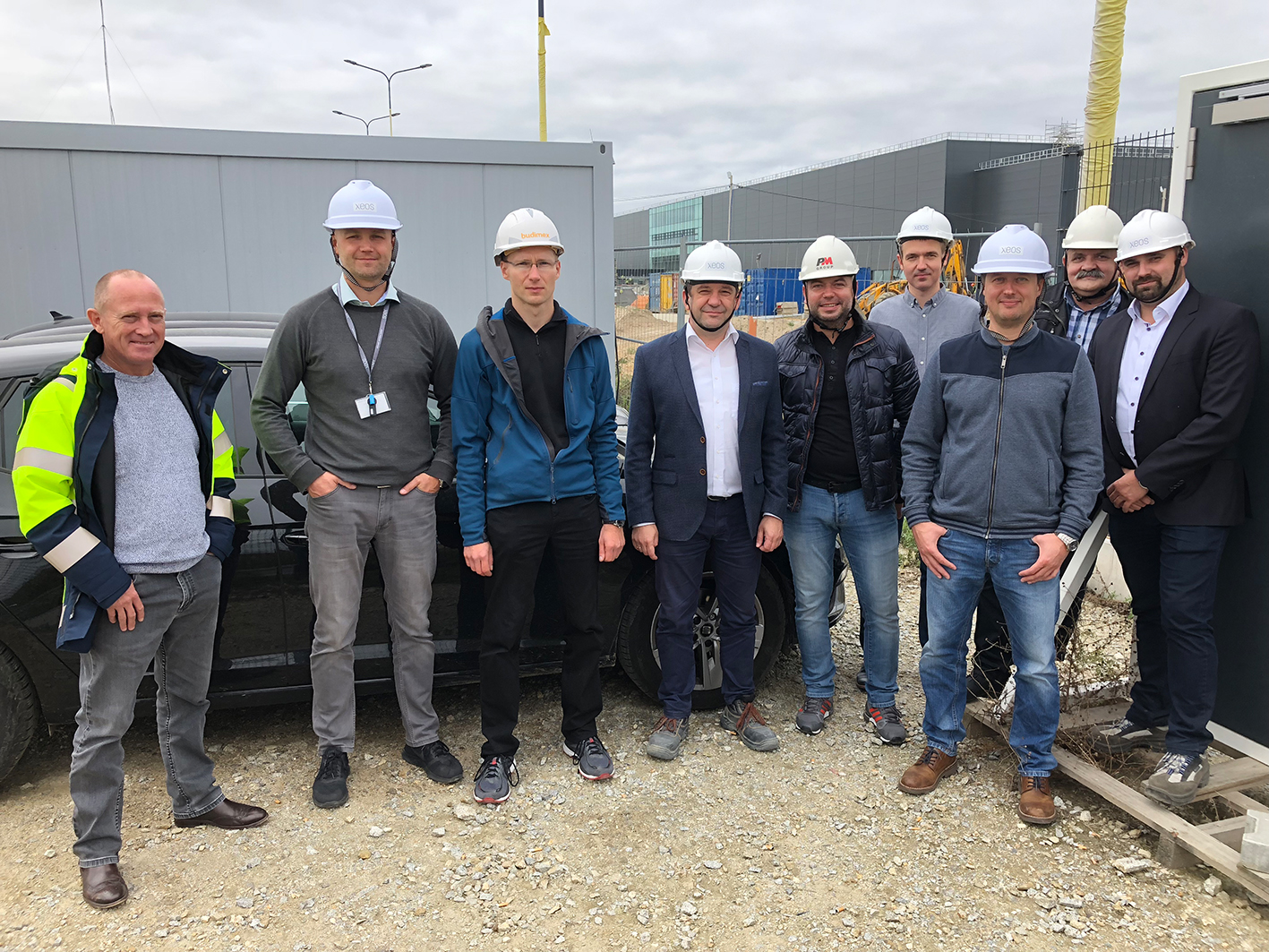

Flexibel, unabhängig und mobil – so sollen sie sein, die Arbeitsplätze der Zukunft: Aufträge von unterwegs aus erteilen, Sicherheitsmaßnahmen unmittelbar initiieren, Arbeitsfortschritte in Echtzeit überprüfen oder einfach nur Arbeitsstunden erfassen, ohne dafür extra ins Büro zu müssen.
Ein Dutzend Module stehen in der Version 2.5 von FAMOSweb, der mobilen CAFM-Lösung von Keßler Solutions, zur Verfügung. Neben umfangreichen Erweiterungen der Basisfunktionen u.a. in den Modulen Auftrag und CAD, wird im Arbeitsschutz der neue Teilprozess Unterweisungen eingeführt. Durch Ausbau von Funktionen und Vereinfachung der Bedienung eröffnen sich weitere Chancen zur Effizienz- und Produktivitätssteigerung. Modern und nutzerfreundlich sind mittels FAMOSweb ganze Prozessketten, bspw. von der Störungsmeldung bis zum erledigten Auftrag, mobil abbildbar.
Alle Module sind als native FAMOSapp nutzbar. Via Tablet oder andere mobile Endgeräte sind bspw. das Scannen von QR- & Barcodes, die Zählerstanderfassung, die Spracheingabe via Mikrofon oder die Bildaufnahmen und deren direkte Verknüpfung zur Datenbank weitere Vorteile, die ein noch effektiveres Arbeiten ermöglichen.
Im Design sorgen klare Formen, kontrastreiche Farbgebung und einfache Grafiken für eine intuitive Bedienbarkeit. Durch eine optimierte Navigation und die bewährte HTML5-Technologie ist FAMOSweb als Alleskönner für jedes Device der perfekte Begleiter in den sich wandelnden Arbeitswelten.
Keßler Solutions hat 2019 die Datenkataloge für die Kostengruppen Bauliche Anlagen (300), Technische Anlagen (400) sowie Außenanlagen (500) nach DIN 276 aktualisiert. Neben den Kostengruppen optimierte das Unternehmen die Kataloge anhand der eigenen Erfahrung bei der Datendigitalisierung namhafter Kunden und stellt die verbesserten Datenbanken für Anlagengruppen und deren Attribute nun allen Kunden zur Verfügung.
( 1.762 Zeichen inkl. Überschriften & Leerzeichen)
 Am 8. Oktober 2019 findet die zweite öffentliche Veranstaltung des BIM-Kompetenz- und Technologiezentrums statt. Die Organisatoren laden zum Fachgespräch “BIM-GIS Integration im Planungs- und Bauprozess” ab 15:00 Uhr in eine ganz besondere Location, nämlich das Paulinum der Universität Leipzig.
Am 8. Oktober 2019 findet die zweite öffentliche Veranstaltung des BIM-Kompetenz- und Technologiezentrums statt. Die Organisatoren laden zum Fachgespräch “BIM-GIS Integration im Planungs- und Bauprozess” ab 15:00 Uhr in eine ganz besondere Location, nämlich das Paulinum der Universität Leipzig.
Während BIM-Informationen essenziell für die Planung und Errichtung von Gebäuden, Brücken, Flughäfen und anderer Anlagen sind, werden GIS-Modelle vor allem für die Infrastrukturplanung verwendet. Der fachliche Workshop soll nun den Brückenschlag dieser zwei Technologiewelten und deren Synergien vermitteln. Hierfür erwarten Sie die folgenden Präsentationen und Referenten:
Abgerundet wird der Workshop nach einer Networking-Kaffee- und Snackpause durch eine fachliche Diskussion und anschließende Gespräche.
Das Fachgespräch wird im Rahmen des Netzwerks BIM – Kompetenz- und Technologiezentrum durch die evermind GmbH (Dienstleister für digitale Geschäftsmodelle) organisiert und stellt in diesem Themenfeld neue Ideen für die praktische Anwendung der bestehenden technologischen Möglichkeiten vor.
Die Anmeldung für das Fachgespräch erfolgt direkt über:
annett [punkt] schumann [at] evermind [punkt] de (Telefon: +49 341 253966-0).
Nach 2017 präsentiert sich Keßler Solutions wieder auf der BIM world MUNICH 2019! Mit am Stand 65 dabei sind die BCS ug der Keßler Group und das BIM Kompetenz- und Technologiezentrum (eigene Website in Erstellung). Die gemeinsame Maxime der Partner:
BIM als nachhaltigste Digitalisierungsmethode im FM- und Immobilienmanagement darf nicht als Selbstzweck betrieben werden: Die Umsetzung in der Praxis ist ein Prozess, der wirtschaftlich und professionell gestaltet werden muss. Dafür bedarf es einer durchgängigen Prozesslösung auf Basis eines komplexen CAFM-Systems, integrierter FM-Prozesse, effektiver Vernetzung aller Stakeholder und des qualifizierten Know-hows. Nur so kann BIM zukunfts- & wettbewerbsfähig eingesetzt werden.
Termin der gleichnamigen Keßler Solutions-Breakout Session: Mittwoch, 27. November, um 13:30 Uhr.
Besuchen Sie die Präsentationen von Keßler Solutions, BCS ug und dem BIM Kompetenz- und Technologiezentrum
am Stand 65 direkt am “Digital FM Hub”!

Ressourcenoptimiertes Bauen wird Pflicht. Daten und Stakeholder werden immer vernetzter. Die Durchgängigkeit von Prozessen muss gewährleistet sein. Technologische Innovationen müssen integriert und nachhaltig genutzt werden. Entscheidungen müssen immer schneller getroffen werden. Ein verlässlicher Partner mit einer professionellen Gesamtstrategie ist das A&O.
Das Systemhaus Keßler hat hierzu Produkte entwickelt, die den gesamten Gestehungs- und Bewirtschaftungsprozess eines Immobilienportfolios abbilden können. Mit dem Werkzeug „BAU“ können Sie bspw. im Rahmen der Bewirtschaftung von der Bauabnahme über eine laufende Zustandsbewertung bis zur Modernisierung alle technischen und betriebswirtschaftlichen Informationen verwalten und zusammenführen. Die CAFM-Lösung FAMOS ist dabei die ideale Entscheidungsgrundlage für anspruchsvolle Immobilienportfolios und dessen Weiterentwicklung.
Die durch eine CAFM-Lösung richtig angewandte Methode BIM ermöglicht es,
Umbaumaßnahmen verursachen für Unternehmen wie Institutionen stets einen hohen Zeit- und Ressourcenaufwand. Zieht bspw. ein Industriebereich in eine neue Werkshalle um oder Verwaltungseinheiten werden umstrukturiert, macht dies zwingend Datenmigrationen und Datenbereinigungen notwendig.
Immobilienbesitzer und -betreiber mit einer Vielzahl an Gebäuden, Flächen und Anlagen sehen sich immer wieder mit Aufwänden in der Datenänderung konfrontiert. Daher hat Keßler Solutions gemeinsam mit namhaften FAMOS Administratoren und Super Usern begonnen, anwendergebundene Werkzeuge für entsprechende Maßnahmen zu entwickeln. Mithilfe der neuen Tools ist ausgewählten Fachanwendern bspw. ein automatisiertes Löschen von Technischen Anlagen oder ganzen Bauwerken möglich, die mit einem Umbau nicht mehr benötigt werden. Die Bearbeitung erfolgt über komplette Objektstrukturen hinweg und wird für die bessere Nachvollziehbarkeit protokolliert.
Der „FAMOS-Werkzeugkasten“ bietet die Möglichkeit, die Werkzeuge der Fachanwender und Admins sicher unterzubringen und vor Benutzung unberechtigter User zu schützen, so dass weder Daten unsachgemäß gelöscht noch Datenmüll produziert werden kann.
Die Werkzeuge selbst sind modular aufgebaut und werden spezifisch an die jeweiligen Kundenbedürfnisse angepasst. Der Kunde kann seine Werkzeuge, so lange die Datenstrukturen gleich bleiben, immer wieder nutzen und somit effektiv Zeit und Geld sparen. Der „FAMOS-Werkzeugkasten“ wird in Zukunft um weitere Werkzeuge ergänzt, um Anwendern ein noch effizienteres wie sicheres Arbeiten zu ermöglichen.
(1.576 Zeichen inkl. Überschrift & Leerzeichen)
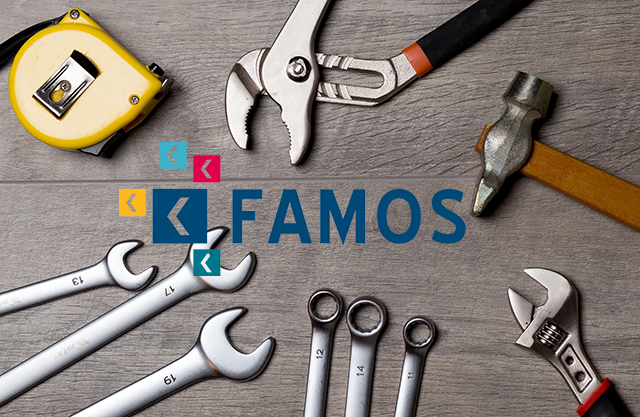
 Es gibt tolle Neuigkeiten von Future Living® Berlin: Ein eingereichtes Paper der Smart Living Plattform ForeSight, an welcher sich Keßler Solutions aktiv beteiligt, wurde für die ICOST 2019 im Oktober in New York City ausgewählt! Die Internationale Konferenz zu Smart Living und Öffentlicher Gesundheit (International Conference On Smart Living and Public Health) ICOST ist eine wichtige Plattform zur Diskussion rund um das Thema KI im Gesundheitswesen (z.B. E-Health), u.a. in Bezug zu Smart Citys (z.B. AAL).
Es gibt tolle Neuigkeiten von Future Living® Berlin: Ein eingereichtes Paper der Smart Living Plattform ForeSight, an welcher sich Keßler Solutions aktiv beteiligt, wurde für die ICOST 2019 im Oktober in New York City ausgewählt! Die Internationale Konferenz zu Smart Living und Öffentlicher Gesundheit (International Conference On Smart Living and Public Health) ICOST ist eine wichtige Plattform zur Diskussion rund um das Thema KI im Gesundheitswesen (z.B. E-Health), u.a. in Bezug zu Smart Citys (z.B. AAL).
Auch in Berlin vor Ort bewegt sich sehr viel. Auf der Homepage von Future Living® Berlin kann man sich den täglichen Baufortschritt seit dem 02.11.2017 anhand von Webcam-Fotos ansehen
Keßler Solutions wird zum Jahreswechsel die vollständige Bewirtschaftung des Quartiers mittels FAMOS übernehmen:
Keßler Solutions betrachtet Smart Products und Smart Services nicht nur als angenehmen oder „hippen“ Lifestyle. Das Hauptaugenmerk liegt auf den großen Potentialen für ein barrierefreies und altersgerechtes Leben. Am Projekt Future Living® Berlin arbeitet Keßler Solutions deshalb aktiv an der Lösung für die Vermietung intelligent ausgestatteter Wohnungen mit. Dafür wird die hauseigene Software FAMOS zur Verfügung gestellt. Mittels FAMOS lassen sich die neuen Services einfach integrieren und transparent abrechnen. Die Prozesslösungen bieten für Vermieter wie Mieter alle Vorteile einer effizienten Vernetzung, wie die bedarfsgerechte Nutzung, unkompliziertes Störungs- und Wartungsmanagement, übersichtliches Controlling durch eine ganzheitliche Dokumentation usw.
„Das moderne, ‚intelligente‘ Wohnen umfasst zukünftig neben der normalen Miete die Integration angenehmer, praktischer oder lebenswichtiger Dienstleistungen. So ermöglichen Smarte Wohnungen und Quartiere vielen Menschen ein selbstbestimmtes Leben in den eigenen vier Wänden.“, so André Keßler, Geschäftsführer von Keßler Solutions. „Das Projekt Future Living® Berlin gibt uns die Chance, aktiv am digitalen Wandel der Lebenswelt teilzuhaben. Gemeinsam mit den verschiedenen Partnern stellen wir eine ressourcenoptimierte wie nachhaltige Umsetzung des Projektes sicher.“
 Im zweiten Halbjahr finden wieder zahlreiche kostenfreie Webinare für FAMOS-Kunden statt. Schulungsleiter Uwe Schmidt vermittelt konkretes Anwenderwissen, stellt Prozessabläufe vor und gibt Hinweise zum strukturierten und effizienten Arbeiten. Die umfangreiche Themenauswahl inkl. spezifischer Übungen bietet neuen wie geübten Nutzern einen schnellen Einstieg für einen einfachen Umgang mit FAMOS. Die Auswahl der Kundenwebinare finden Sie HIER im zweiten Reiter “Kundenwebinare”.
Im zweiten Halbjahr finden wieder zahlreiche kostenfreie Webinare für FAMOS-Kunden statt. Schulungsleiter Uwe Schmidt vermittelt konkretes Anwenderwissen, stellt Prozessabläufe vor und gibt Hinweise zum strukturierten und effizienten Arbeiten. Die umfangreiche Themenauswahl inkl. spezifischer Übungen bietet neuen wie geübten Nutzern einen schnellen Einstieg für einen einfachen Umgang mit FAMOS. Die Auswahl der Kundenwebinare finden Sie HIER im zweiten Reiter “Kundenwebinare”.
Melden Sie sich direkt an und besuchen Sie unsere Online-Webinare bequem und zeitsparend von Ihrem Arbeitsplatz aus!
Entdecken Sie auch die offenen Webinaren (ebenso kostenfrei) und mit diesen die vielfältigen Möglichkeiten, die FAMOS Ihnen bietet. Und stöbern Sie doch mal in unserem Schulungskatalog und nutzen Sie die Vorteile einer persönlichen Schulung bei Ihnen vor Ort oder bei uns in Leipzig..
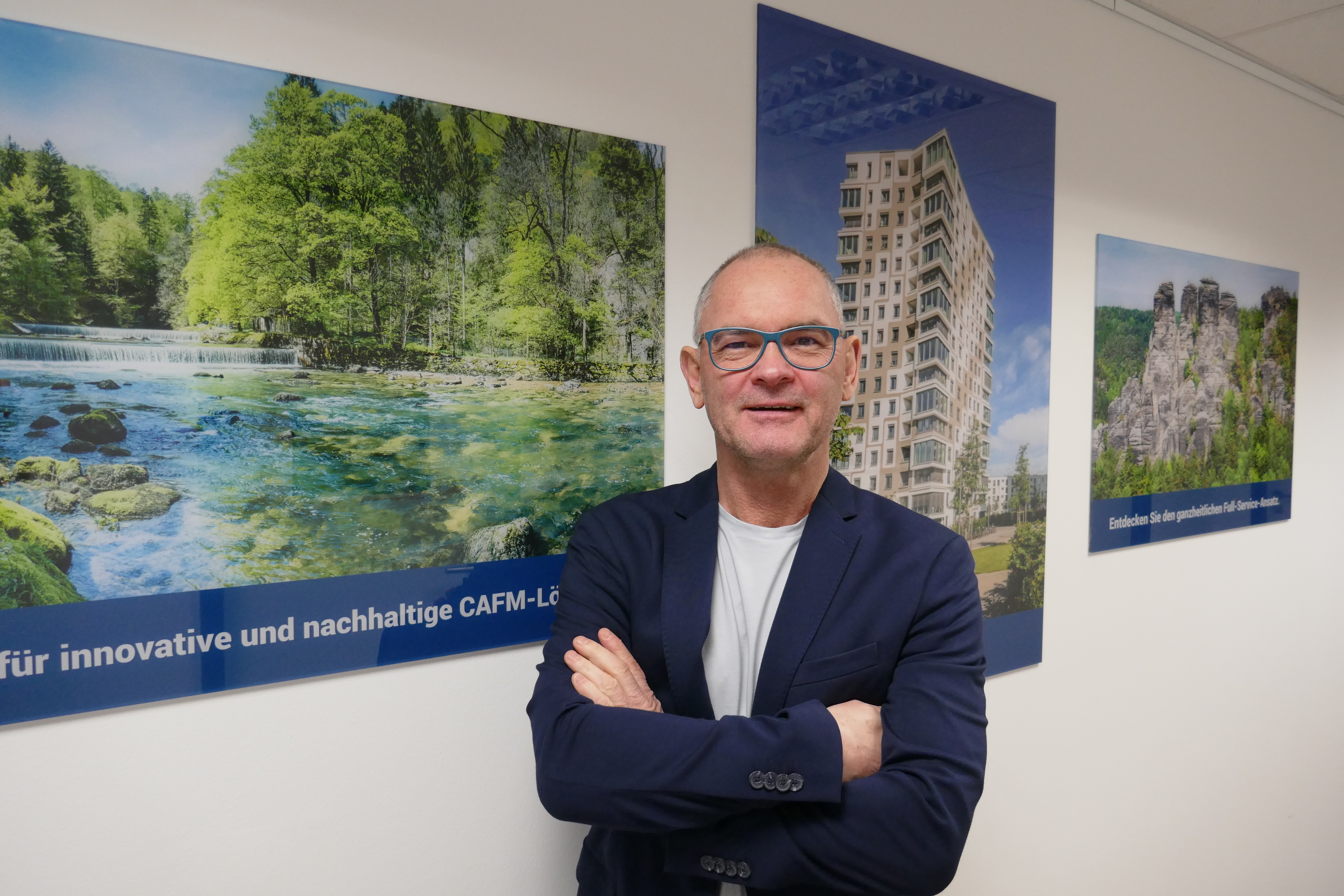
Der mittlerweile vierte CAFM-Trendreport ist diesen Monat erschienen. Befragt wurden 88 CAFM-Anbieter und 322 Anwender zur Marktentwicklung und Trends – ein erneutes Teilnehmerwachstum gegenüber den Vorjahren. Initiator und Herausgeber ist der GEFMA Arbeitskreis Digitalisierung (ehemals Arbeitskreis CAFM), dem auch der Entwicklungsleiter von Keßler Solutions, Nino Turianskyj, angehört. Hier geht’s zur News auf der GEFMA-Website.
Das 60 Seiten umfassende Marktbarometer ist auf der Website der GEFMA gegen eine Schutzgebühr von 30,00€ zzgl. MwSt. erhältlich.
Mit den Begriffen “Digitaler Fortschritt” und “Digitale Technologien” kommt man auf die nächsten Definitionsebene der Digitalisierung:
Als Formen des Digitalen Fortschritts gelten Industrie 4.0, Cyber-physical systems (CPS) und das Internet of Things (IoT). Sie befördern und beeinflussen sich gegenseitig, wofür predictive maintenance (vorbeugende Instandhaltung) ein ideales Beispiel ist.
Die sich mit dem Digitalen Fortschritt entwickelnden Digitalen Technologien sind bspw. Smart “X”, Künstliche/ Artifizielle Intelligenz (KI/ AI), Virtual/ Augmented Reality (VR/ AR) und Big Data aber auch Robotik, Cloud Computing und Social Media.
Wir definieren komprimiert die Formen Digitalen Fortschritts und Digitaler Technologien, benennen Anwendungsmöglichkeiten und erklären unseren Ansatz zur Prozessoptimierung auf der Website Digitalisierung als Chance.
Entdecken Sie unsere Broschüre Digitalisierung als Chance (pdf) oder lesen Sie auf unserer Website weiter:
In der Ausgabe 4/2019 des AUTOCAD MAGAZIN werden in der “Expertenrunde” ein halbes Dutzend Unternehmer zu “Wo steht BIM im Facility Management?” befragt. Im Detail ging es um die wichtigsten Herausforderungen der Integration von Building Information Modeling in das CAFM, die Datendurchgängigkeit von Planung bis Betrieb des “digitalen Zwillings” sowie Standards, Austauschformate und Verbesserungspotentiale im Datenmanagement.
Hier das Statement des Keßler Solutions-Geschäftsführer André Keßler:
Die Integration von BIM-Modellen und -Daten in ein CAFM-System stellt die wichtigste Herausforderung im Rahmen der digitalen Bewirtschaftung dar. So ist die Durchgängigkeit der Daten von der Planung bis zum Betrieb, bspw. in einem digitalen Gebäudezwilling, die Grundlage für eine schlüssige Dokumentation und optimale Bewirtschaftung des Immobilienbestandes, insbesondere um spätere Bewirtschaftungskosten zu minimieren und bestehende und zukünftige Prozesse zu optimieren.
Hierbei steht die Branche vor völlig neuen Herausforderungen. Schließlich befindet sich der so genannte „digitale Gebäudezwilling“, als Abbild des Bauwerks, mehrere Jahrzehnte in der Bewirtschaftung. Neben dem Thema BIM an sich spielt ebenso die Thematik der smarten Digitalisierung und Vernetzung der verbauten Anlagen und Komponenten innerhalb der Gebäudeinfrastruktur eine zentrale Rolle sowie die Nachhaltigkeit der Bauprojekte in Hinblick auf Renaturalisierungskonzepte.
Die Potentiale sind deutlich, die Motivation ist groß – ebenso die damit verbundenen Herausforderungen. Was in den theoretischen Ansätzen logisch und zielführend klingt, ist aufgrund der Komplexität in der Praxis sehr vielschichtig. Wir von Keßler Solutions beschäftigen uns mit der Integration von BIM in das CAFM-System und der Entwicklung von Standards um die Prozessdurchgängigkeit zu gewährleisten. Die technische Herausforderung ist die transparente, digitale Vernetzung aller Stakeholder, auch in Hinblick auf Fragen zur Datensicherheit, welche teils nur auf Basis bestehender Rechte und Normen beantwortet werden können.
Das Betriebssystem der Immobilien ist dabei das CAFM-System FAMOS, welches neben den BIM-spezifischen Datenmodellen auch Module zur vollständigen Bauwerksdokumentation zur Verfügung stellt. Die Lösung aus Leipzig setzt im Rahmen der Digitalisierung gezielt auf den Schwerpunkt der Prozessdurchgängigkeit über alle Gebäudelebensphasen. Für die Integration und den bidirektionalen Abgleich von BIM-Daten mit dem CAFM-Modell existieren manuelle und vollautomatisierte Plausibilitätsprüfungen. Den dafür entwickelten BIMflow setzen bereits namhafte Großstädte und Industriekunden ein. Durch weitere digitalisierte Prozesse, z.B. in der Instandhaltung oder Vermietung, werden die Daten im Betrieb so angereichert, dass aufwändige Kosten zur Lokalisierung, Vermessung und Informationsgewinnung minimiert werden können. Weitere Lösungen existieren weiterhin im Bereich der Begehung und Zustandsbewertung, bis zur Budgetierung und dem Portfoliocontrolling.
Um die Herausforderungen von BIM zu meistern, initiierten wir 2018 mit Partnern verschiedener Branchen das BIM-Kompetenz- und Technologiezentrum, welches offen für weitere interessierte Unternehmen und Institutionen ist.
 Das Team von Keßler Solutions kann Ende Mai nicht nur stolz auf ein großartiges 18. FAMOS User Forum sein, sondern auch auf den “Mit-“Gewinn eines SmartHome Deutschland Award: Die GSW Sigmaringen hatte sich mit Future Living® Berlin in der Kategorie “Beste realisierte Projekte” beworben. Am 29. Mai wählte die Jury das Projekt und “sein tolles Partnernetzwerk” in dieser Kategorie auf den ersten Platz! Danke – Wir freuen uns sehr!
Das Team von Keßler Solutions kann Ende Mai nicht nur stolz auf ein großartiges 18. FAMOS User Forum sein, sondern auch auf den “Mit-“Gewinn eines SmartHome Deutschland Award: Die GSW Sigmaringen hatte sich mit Future Living® Berlin in der Kategorie “Beste realisierte Projekte” beworben. Am 29. Mai wählte die Jury das Projekt und “sein tolles Partnernetzwerk” in dieser Kategorie auf den ersten Platz! Danke – Wir freuen uns sehr!
Bekanntermaßen ist die Mission von Keßler Solutions die Digitalisierung und Automatisierung von Daten und Prozessen. Dies beinhaltet bspw. die effektive Datenerfassung und -verarbeitung, professionelle Beratung zur und Begleitung der Prozessoptimierung sowie die Umsetzung von Innovationen für zahlreiche namhafte Kunden verschiedenster Branchen. Dafür investieren wir bereits seit Jahren in digitale Zukunftstechnologien, u.a. im Bereich Smart Living.
Unser Unternehmen betrachtet Smart Products und Smart Services nicht nur als angenehmen oder „hippen“ Lifestyle. Das Hauptaugenmerk von Keßler Solutions liegt auf den großen Potentialen für ein barrierefreies und altersgerechtes Leben. Am Projekt Future Living® Berlin arbeiten wir deshalb aktiv an der Lösung für die Vermietung intelligent ausgestatteter Wohnungen mit. Dafür wird die hauseigene Software FAMOS zur Verfügung gestellt. Mittels FAMOS lassen sich die neuen Services einfach integrieren und transparent abrechnen. Die Prozesslösungen bieten für Vermieter wie Mieter alle Vorteile einer effizienten Vernetzung, wie die bedarfsgerechte Nutzung, unkompliziertes Störungs- und Wartungsmanagement, übersichtliches Controlling durch eine ganzheitliche Dokumentation usw.
„Das moderne, ‚intelligente‘ Wohnen umfasst zukünftig neben der normalen Miete die Integration angenehmer, praktischer oder lebenswichtiger Dienstleistungen. So ermöglichen Smarte Wohnungen und Quartiere vielen Menschen ein selbstbestimmtes Leben in den eigenen vier Wänden.“, so André Keßler, Geschäftsführer von Keßler Solutions. „Das Projekt Future Living® Berlin gibt uns die Chance, aktiv am digitalen Wandel der Lebenswelt teilzuhaben. Gemeinsam mit den verschiedenen Partnern stellen wir eine ressourcenoptimierte wie nachhaltige Umsetzung des Projektes sicher.“
Am 22. Mai 2019 präsentiert sich das 2018 u.a. von Keßler Solutions initiierte BIM-Kompetenz- und Technologiezentrums im Mediencampus VILLA IDA, Leipzig, erstmals der Öffentlichkeit: Im Rahmen des Fachgesprächs in Leipzig werden die technischen Möglichkeiten des BIM ausgelotet und die Herausforderungen bei den Anwendern, wie die Digitalisierung großer Teile des Gebäudeverwaltungssektors, als auch die Vereinheitlichung und Verbesserung der zugrundeliegenden Prozesse, diskutiert.
Der Begründer des Multi-Modell Ansatzes Prof. Dr.-Ing. Raimar J. Scherer (Institut für Bauinformatik der TU Dresden) wirft einen Blick auf die BIM-Zukunft energie-effizienter Gebäude. Weitere Vorträge renommierter Partner wie der BMW Group befassen sich mit BIM-Anwendungen in der Praxis von Bauplanung und Gebäudebetrieb sowie innovativer Datenerfassung (hybride Über- und Unterwassererfassung). Abschließend gibt es eine Podiumsdiskussion mit allen Rednern und Zeit für Networking beim gemeinsamen Mittagessen.
Ziele des BIM-Kompetenz- und Technologiezentrums sind u.a. eine praktische wie praktikable Umsetzung und nachhaltige Anwendung des Building Information Modeling. Die Einbeziehung betroffener Stakeholder ermöglicht das Identifizieren von offenen Punkten im Immobilienlebenszyklus sowie das schnelle Auffinden von Synergiepotentialen. Ein Dutzend Partner beschäftigen sich im BIM- Kompetenz- und Technologiezentrum bereits mit Fragestellungen zu technischen Grenzen, Anforderungen an die Infrastruktur, BIM-relevanten Gesetzen und Normen, zukünftigen Geschäftsmodellen und weiterem mehr. Das Netzwerk ist offen für weitere Partner, die an einer aktiven Mitarbeit interessiert sind.
Für das Fachgespräch wird ein Teilnehmerbeitrag in Höhe von 89,00€ (netto inkl. Catering) erhoben. Die Anmeldung erfolgt über das Webportal XING (auch ohne Log-In möglich) oder kontaktieren Sie uns direkt.

Die Keßler Real Estate Solutions GmbH hat sich Zeit mit dieser Entscheidung gelassen: Die neue Verpackung Servparc für alte Konzepte (inServ) hat nicht überzeugt. Wie 2018 wird das Unternehmen vor Ort nicht mit einem eigenen Stand zugegen sein, sondern als Messebesucher den Erfolg der Neuausrichtung bewerten. Der Spezialist für Prozess- und Datendigitalisierung setzt wie im Vorjahr die Prioritäten auf eigene Veranstaltungen, neue F&E-Projekte und einen direkteren Anwenderbezug.
In wenigen Wochen stehen in Leipzig deshalb zwei wichtige Events von Keßler Solutions an: Das 18. FAMOS User Forum, die hauseigenen Anwendertage mit Schulungen und Projekttag, finden vom 22. bis 24. Mai statt. Zur Tagung am 23. Mai präsentiert sich das Unternehmen seinen Kunden und Partnern rund um das Thema Prozessdigitalisierung sowie wichtigste
Neuerungen der Software, neue Services und ein Ausblick auf konkrete Ziele der kommenden Monate. Zudem gibt es Gastvorträge des Johanniter-Unfall-Hilfe e.V. zum technologisch fortschrittlichen Bauen unter Beachtung sozialer Gesichtspunkte sowie der Gräbert GmbH zum Thema CAD. Nach dem Erfolg 2018 werden auch in diesem Jahr Erfolgsgeschichten aus der Praxis mit und durch die Anwender selbst vorgestellt. Besonderes Highlight wird die erste öffentliche Vorstellung des Digitalen Serviceheftes und die Übergabe des Keßler-Kumpan-Elektrorollers durch den Partner e-bility. Die anschließende Podiumsdiskussion 2019 dreht sich um “CAFM im fortwährenden Wandel – Prozessdigitalisierung, smart living, Industrie 4.0 und mehr”. Open Spaces, Stände und Papers laden zum sofortigen Diskutieren und Austesten ein und runden das Tagungsprogramm ab.
Im gleichen Atemzug stellt sich das 2018 initiierte BIM Kompetenz- und Technologiezentrums erstmals öffentlich vor: Im Fachgespräch am 22. Mai in Leipzig sollen die technischen Möglichkeiten des BIM ausgelotet und die Herausforderungen bei den Anwendern, wie die Digitalisierung großer Teile des Bauplanungs- und Gebäudeverwaltungssektors, diskutiert werden. Einen Einstieg geben Prof. Dr.-Ing. Raimar J. Scherer (Institut für Bauinformatik der TU Dresden), Begründer des Multi-Modell Ansatzes, sowie Vorträge renommierter Partner aus dem Bereich innovativer Datenerfassung und BIM im Gebäudebetrieb. Ziele des BIM Kompetenz- und Technologiezentrums sind u.a. eine praktische wie praktikable Umsetzung und nachhaltige Anwendung des Building Information Modeling unter Einbeziehung aller betroffenen Stakeholder. Das BIM Kompetenz- und Technologiezentrums ist offen für weitere Partner, die an einer aktiven Mitarbeit interessiert sind. (Anmeldung für den 22. Mai via XING-Event möglich. Teilnahmekosten: 89,00 €/ Person, netto).
Keßler Solutions engagiert sich nicht nur aktiv beim Thema BIM, sondern auch im Bereich Forschung- und Entwicklung von KI: Im April startete das Projekt ForeSight u.a. mit dem Deutschen Forschungszentrum für Künstliche Intelligenz (DFKI), der GSW Sigmaringen und der Friedrich-Alexander-Universität Erlangen-Nürnberg (FAU). Ziel ist die Entwicklung einer Plattform für intelligente und vorausschauende Smart Living Services im Pilotprojekt Future Living® Berlin.
Ergänzt wird das Jahresprogramm von Keßler Solutions mit der Präsenz auf der BIM world munich sowie auf kleineren Messen und Tagungen mit hohem Anwenderbezug, z.B. Kommunales Forum für Informationstechnik KomFIT, Branchenmessen und -kongresse wie „Vernetzt Planen und Produzieren“ (Tagung der TU Chemnitz), Events von Partnern und Kunden, Nutzergruppentreffen etc.
(3.586 Zeichen inkl. Überschrift & Leerzeichen)
Die aktuelle Version von FAMOSweb steht nun zur Verfügung. Neu im Webportal findet sich das Modul ServicePoint. Es unterstützt die Nutzer bei der effizienten Organisation ihrer Arbeitsprozesse durch kurze Kommunikationswege und einfache Abläufe. Der neue ServicePoint ist mobil einsatzfähig. So können bspw. schnell und direkt vor Ort Probleme erfasst oder Bedarfe angezeigt und unmittelbar in die weitere Bearbeitung übergeben werden. Dies spart nicht nur Zeit und Aufwand sondern vereinfacht auch Ihr Controlling. Das Ticketsystem bietet einen schnellen Überblick über Status, Inhalte und Prioritäten von Serviceanforderungen und ermöglicht ein einfaches Bearbeiten. Die einzelnen Tickets sind strukturiert und übersichtlich angelegt, so dass sich die Servicebearbeiter voll und ganz auf ihre Aufgaben konzentrieren können.
Nachtrag: Kunden finden das Datenblatt zum Web-Servicepoint im Downloadbereich!
Wir von Keßler Solutions haben uns nicht nur die Digitalisierung und Automatisierung von Daten und Prozessen zum Ziel gesetzt, sondern auch die Förderung von BIM und dessen Integration ins FM und insbesondere ins CAFM. Die praktikable Umsetzung und nachhaltige Anwendung des Building Information Modeling sind dabei bedeutende Ziele und betreffen verschiedenste Stakeholder. Deshalb initialisierten wir 2018 gemeinsam mit der Keßler Ingenieur Consult Vermessungs- und Ingenieurgesellschaft mbH und der BCS GmbH das BIM-Kompetenz- und Technologiezentrum. Am 22. Mai findet dazu in Leipzig auf dem Mediencampus Villa Ida die öffentliche Auftaktveranstaltung statt.
Im BIM-Fachgespräch werden wir die technischen Möglichkeiten des Building Information Modeling ausloten und die Herausforderungen bei den Anwendern, wie die Digitalisierung großer Teile des Bauplanungs- und Gebäudeverwaltungssektors als auch die Vereinheitlichung und Verbesserung der zugrundeliegenden Prozesse, diskutieren.

Zum Einstieg freuen wir uns besonderes auf Herrn Prof. Dr.-Ing. Raimar J. Scherer vom Institut für Bauinformatik der TU Dresden, den Begründer des Multi-Modell Ansatzes sowie Praxisvorträge renommierter Partner aus dem Bereich innovativer Datenerfassung und der Nutzung von BIM im Gebäudebetrieb.
Es wird ein Teilnehmerbeitrag in Höhe von 89,00€ (netto) erhoben. Die Anmeldung erfolgt über das Webportal XING (auch ohne Log-In möglich).
PROGRAMM
9:30 Uhr Begrüßung und thematische Einführung
durch Annett Schumann (evermind GmbH) und Jens Straube (Keßler Real Estate Solutions GmbH)
Ein semantisch-numerisches BIM Labor für energie-effiziente Gebäude
(Prof. Dr.-Ing. Raimar J. Scherer, Technische Universität Dresden)
BIM – Was dafür erforderlich ist. Fusion von Geodäsie und Bauwesen in Binnen- und Seehäfen
(Karsten Holste , WK Consult Gruppe/ Hydromapper GmbH, Hamburg)
10:45 Uhr Kaffeepause
Building Information Modeling – der Weg zum integrierten Lebenszyklus bei der BMW Group
(Markus Kiefl, BMW Niederlassung München)
Wie BIM die Baukultur geändert hat und ändern wird. Erfahrungsbericht aus Sicht der Generalplanung.
(Justus Tiepmar, IPROconsult GmbH, Niederlassung Leipzig)
12:30 Uhr Podiumsdiskussion
13:30 Uhr Gemeinsames Mittagessen
Im Anschluss: Geschlossene Veranstaltung (Treffen der Netzwerkpartner des BIM-Kompetenz- und Technologiezentrums)
LOCATION: Mediencampus Villa Ida
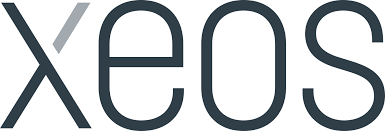
Im Sommer 2018 begrüßte Keßler Solutions das angehende Instandhaltungszentrum für Triebwerke XEOS als neuen FAMOS-Kunden. Das Gemeinschaftsunternehmen von Lufthansa Technik und GE Aviation bei Breslau nimmt in Kürze seinen Betrieb auf. Am infrastrukturell günstig gelegenen Standort werden zukünftig GE-Triebwerksmuster der neuesten Generation gewartet, repariert und überholt. Keßler Solutions unterstützt das hochmoderne Instandhaltungszentrum mit innovativen Prozesslösungen:
Die Erfassung aller TGA wie Produktionsmaschinen und Betriebsmittel wurde bereits erfolgreich abgeschlossen – inklusive der Kennzeichnung mit QR-Codes, so dass beim Einscannen direkt an der technischen Anlage auf wichtige Informationen, z.B. zur Wartungs- und Instandhaltungshistorie, zugegriffen werden kann.
Im nächsten Schritt erfolgt der Umstieg auf eine komplett papierlose Verwaltung. Mit Hilfe des FAMOSweb-Portals wird die nachhaltige Idee des „paperless office“ spätestens im zweiten Quartal umgesetzt. Verschiedene automatisierte Prozesse wie Störungsmeldung, Stundenschreibung oder Auftragsmanagement sowie die Integration von Schnittstellen, wie zum Warenwirtschaftssystem SAP, ermöglichen diesen Digitalisierungsschritt.
Ein weiteres anstehendes Projekt ist die automatisierte Lagerverwaltung und Bereitstellung von Ersatzteilen via Schnittstelle zu einem dynamischen Lager- und Bereitstellungssystem. Für Keßler Solutions ist XEOS der erste Kunde mit einem solchen System und nimmt im Rahmen der agilen Entwicklung dadurch eine Vorreiterrolle ein.
Durch die Zusammenarbeit mit XEOS kann Keßler Solutions weitere Erfahrungen auf dem internationalen Markt sammeln. Dies hat unter anderem den Vorteil, dass internationale Kunden oft nicht an umfangreiche Normen und Richtlinien wie deutsche Unternehmen gebunden sind. Internationale FAMOS-Anwender sind daher offener, flexibler und auch experimentierfreudiger mit der Software, wodurch leichter neue Potentiale aufgedeckt und Verbesserungsvorschläge entwickelt werden können. Diese Erfahrungswerte kommen dann wiederum den deutschen Kunden zu Gute, die von modernen und zukunftsfähigen Softwarelösungen profitieren.
Im Zuge zukünftiger Expansionen von XEOS ist ein innovativer Prüfstand für Flugzeugtriebwerke geplant. Ab 2021 soll außerdem ein weiteres, aktuell noch in der Entwicklung befindliches Triebwerksmuster zum Leistungsspektrum hinzukommen. Bereits in den kommenden vier Jahren wird sich die Belegschaftszahl voraussichtlich auf 600 Mitarbeite-rInnen vervierfachen. Keßler Solutions wird XEOS auf diesem Weg begleiten und aktiv unterstützen. Möglich ist dies u.a. auch dadurch, dass die hauseigene Software FAMOS alle nötigen Voraussetzungen für die Sicherheitszertifikate der Luftfahrtindustrie erfüllt.

Keßler Solutions vor Ort bei XEOS im Herbst 2018
(2.853 Zeichen inkl. Überschrift & Leerzeichen)
VIDEO: Bau des Instandhaltungszentrums im Zeitraffer.
Einmal im Jahr lädt Keßler Solutions seine Anwender, Kunden und Partner zum FAMOS User Forum. 2019 jährt sich dieses bereits zum 18. Mal. Die Tagung am 23. Mai 2019 findet im 2018 eröffneten Vienna House Leipzig statt. Das FAMOS User Forum wird traditionell umrahmt von zwei praxisorientierten Tagen, die den Teilnehmern die Möglichkeit geben, ihr Wissen und ihre Fertigkeiten im Umgang mit der Software-Lösung FAMOS aktiv zu erweitern und zu verbessern (Achtung: begrenzte Platzzahl!).
UPDATE: Die Plätze für den ersten Schulungstag sind bereits ausgebucht. Falls es weitere Interessenten gibt, lassen Sie es uns bitte zeitnah wissen, damit wir bei Bedarf eine andere Schulungslocation anmieten!
Zusätzlich veranstaltet das Team von Keßler Solutions am Freitag, dem 24. Mai 2019, einen Dialog- und Projekttag in den Büroräumen im Herzen von Leipzig. Nach Terminabsprache ist dies auch für interessierte Unternehmen, Partner und Studierende möglich – Kommen Sie dazu gern auf uns zu (s.u.)!
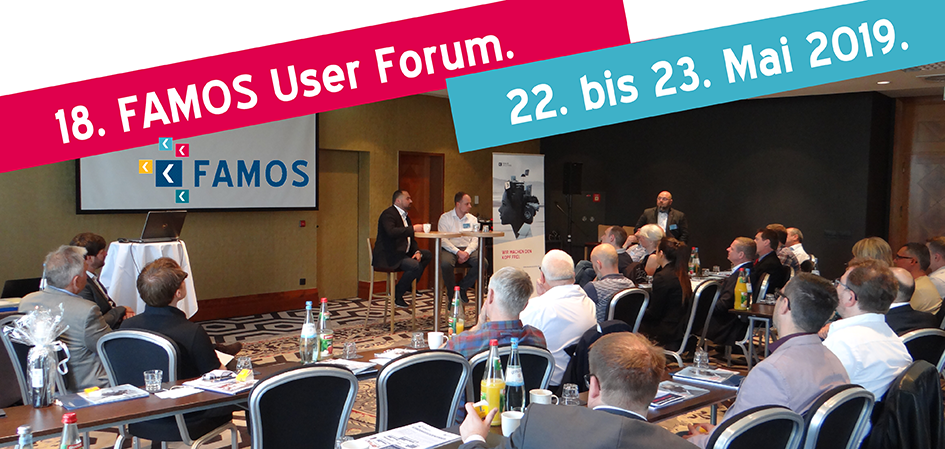
Die jährliche Plattform für den Austausch von Innovationen, Erfahrungen und Ideen bietet 2019*:
Bei Interesse an einer Teilnahme, an Beteiligungsmöglichkeiten im Programm (Redebeitrag, Stand oder Aktion) und zu organisatorischen Punkten wenden Sie sich bitte an: kbretschneider[a]kesslersolutions[.]de. Wir freuen uns auf Sie!
* Änderungen vorbehalten

Wir wissen, dass die Bewältigung eines Sanierungsstau eine große Herausforderung ist: Die Formulierung von Baubedarfen ist schwierig, ebenso das Setzen von Prioritäten, die andere – interne wie externe – Stakeholder nachvollziehen können. Und dies alles teils auf Basis von Unterlagen, die unübersichtlich in verschiedenen analogen und/oder digitalen Ordnern, Dateien und Listen abgelegt sind.
Unser Lösungvorschlag von der Datenerfassung über die digitale Bauakte bis zum BIM-gerechten Second Life:
Lesen Sie für mehr Informationen dazu das Datenblatt “Sanierungsstau meistern”.
Bildquelle: © amyinlondon – stock.adobe.com
Seit dem neuen Jahr bieten wir allen Interessierten neue Offene Webinare an! Diese informieren Sie über die vielfältigen Möglichkeiten der Prozess- und Datendigitalisierung und geben Hinweise zu aktuellen FM-Themen. Die umfangreiche Themenauswahl ermöglicht den schnellen und effektiven Überblick über die CAFM-Welt und einen kinderleichten Einstieg in die FAMOS-Familie. Eine Anmeldung ist kostenfrei möglich.
Melden Sie sich HIER direkt an und besuchen Sie unsere Online-Webinare bequem und zeitsparend von Ihrem Arbeitsplatz. Wir freuen uns auf Sie!
Im frischen KRES-Look und mit aktualisierten Inhalten finden Sie ab sofort im Downloadbereich unsere Datenblätter zu:
Freisetzung hoher Einsparpotentiale , planbare & effektive Wartungen, transparente & leicht auswertbare Daten, effiziente & nachvollziehbare Abläufe.
Sicheres und planbares Arbeiten im Gebäude- und Energiemanagement – Sicherheit bei der Organisation – Einhaltung Ihrer Betreiberpflichten.